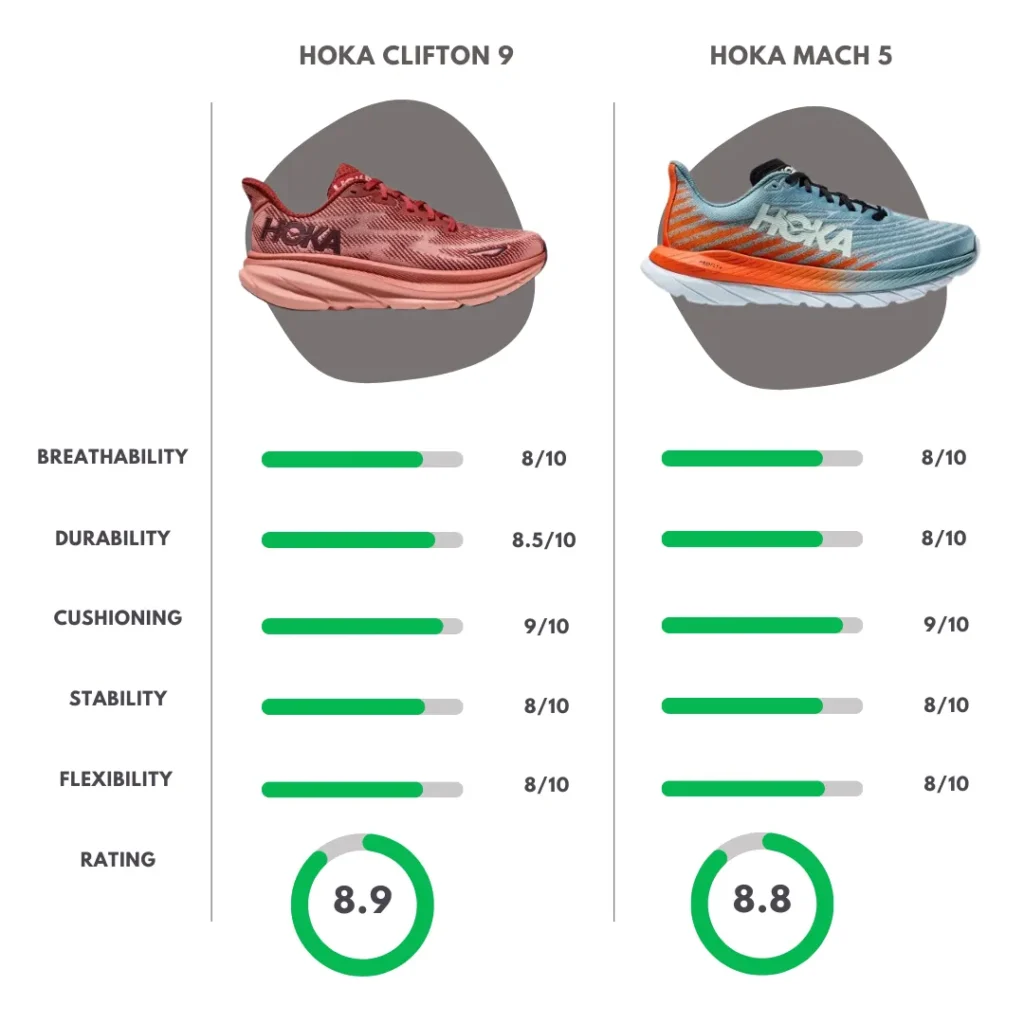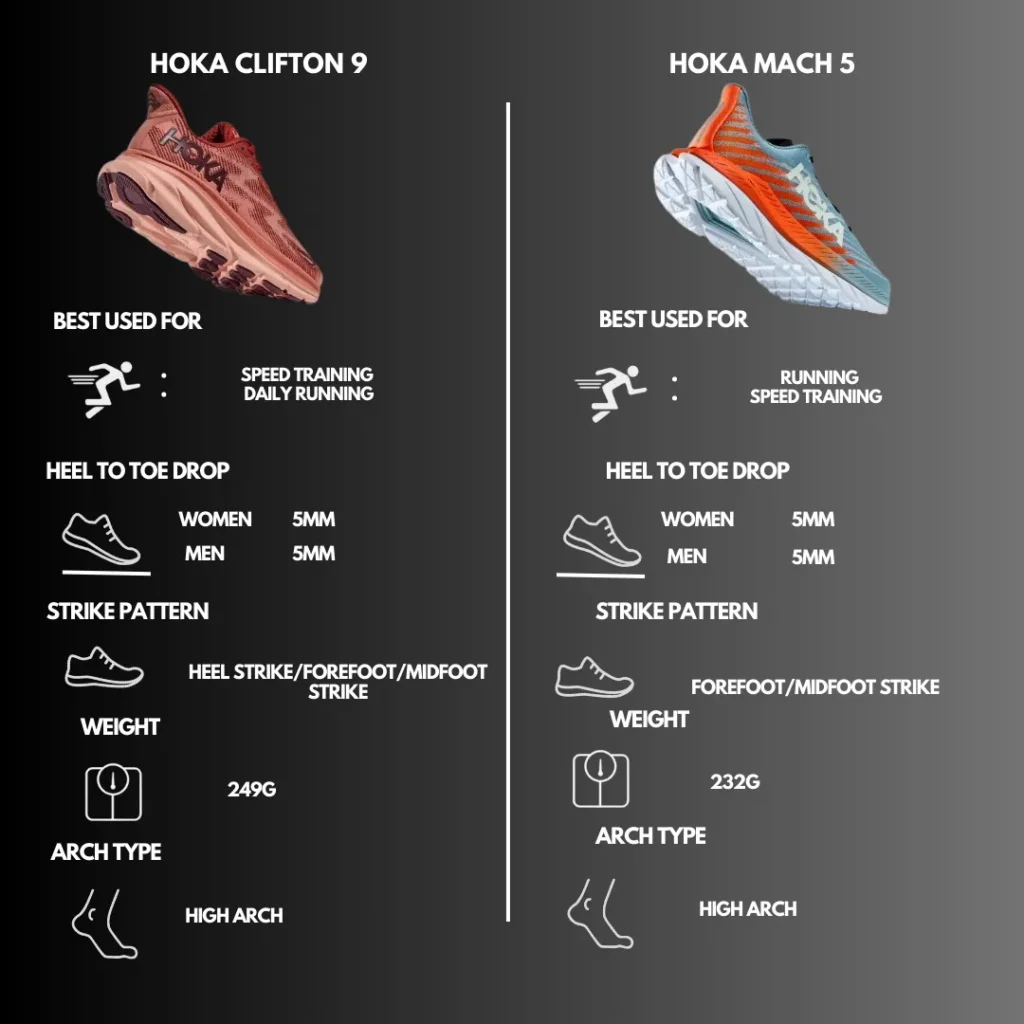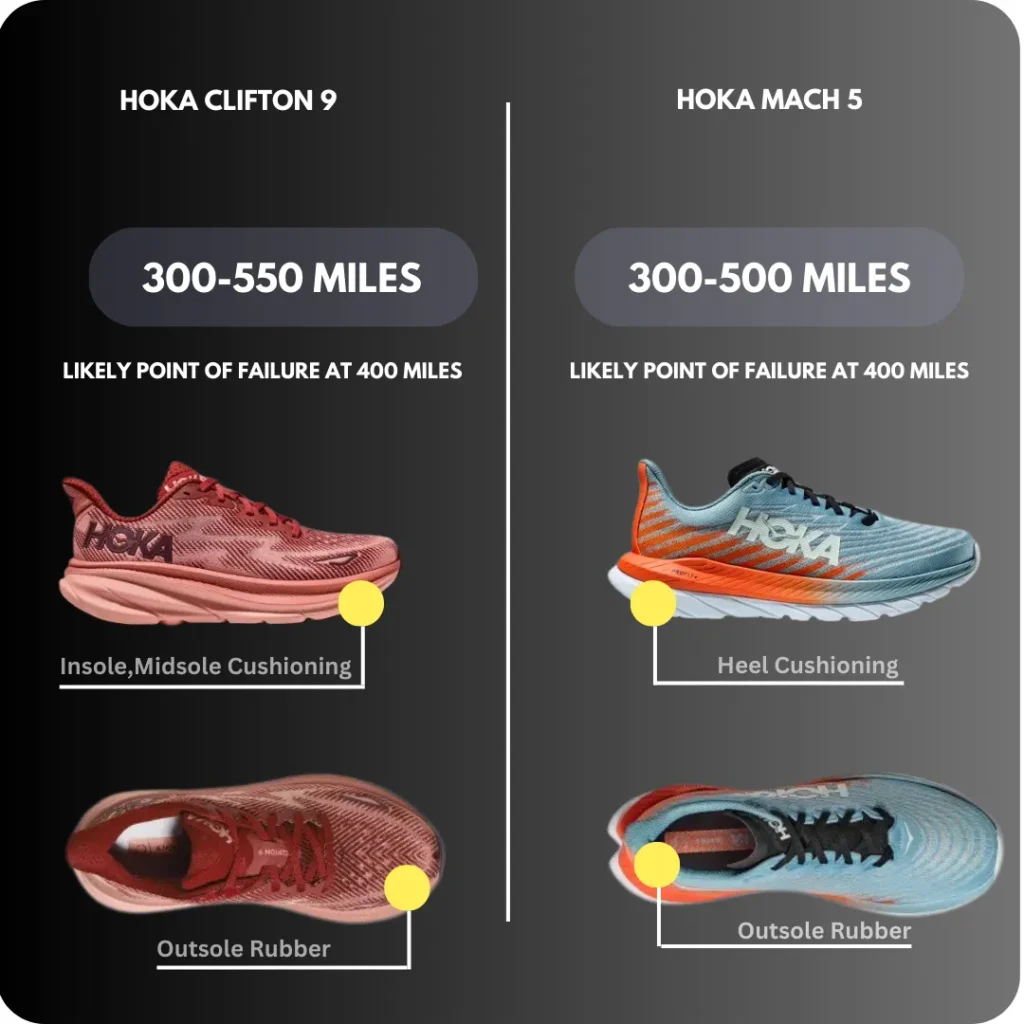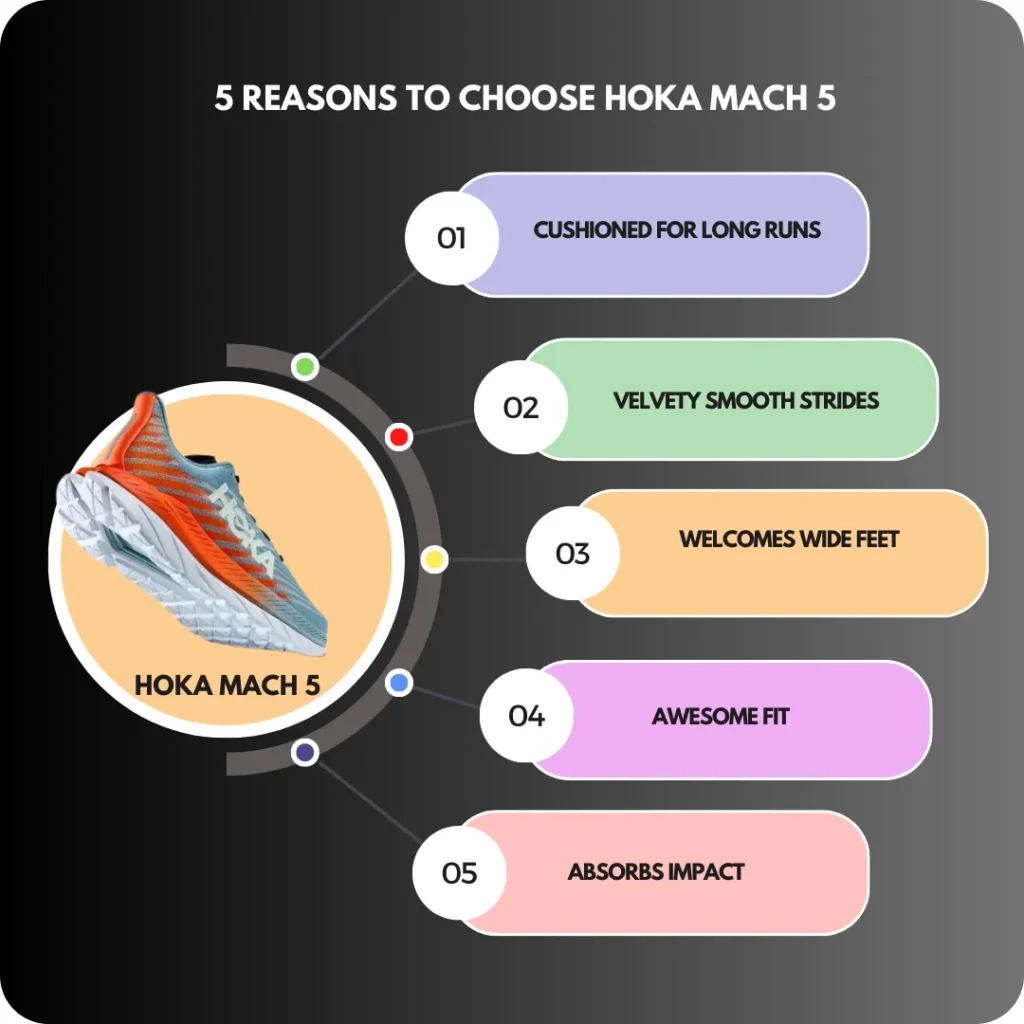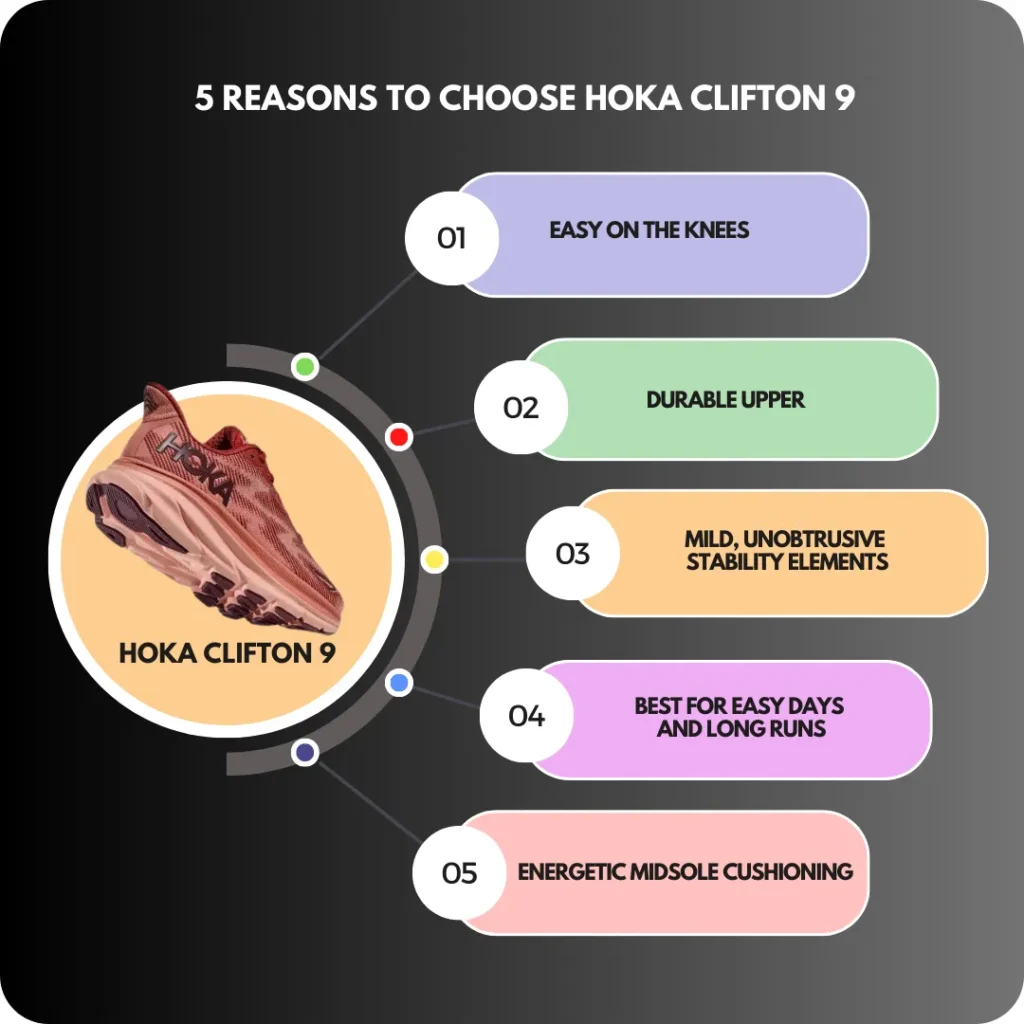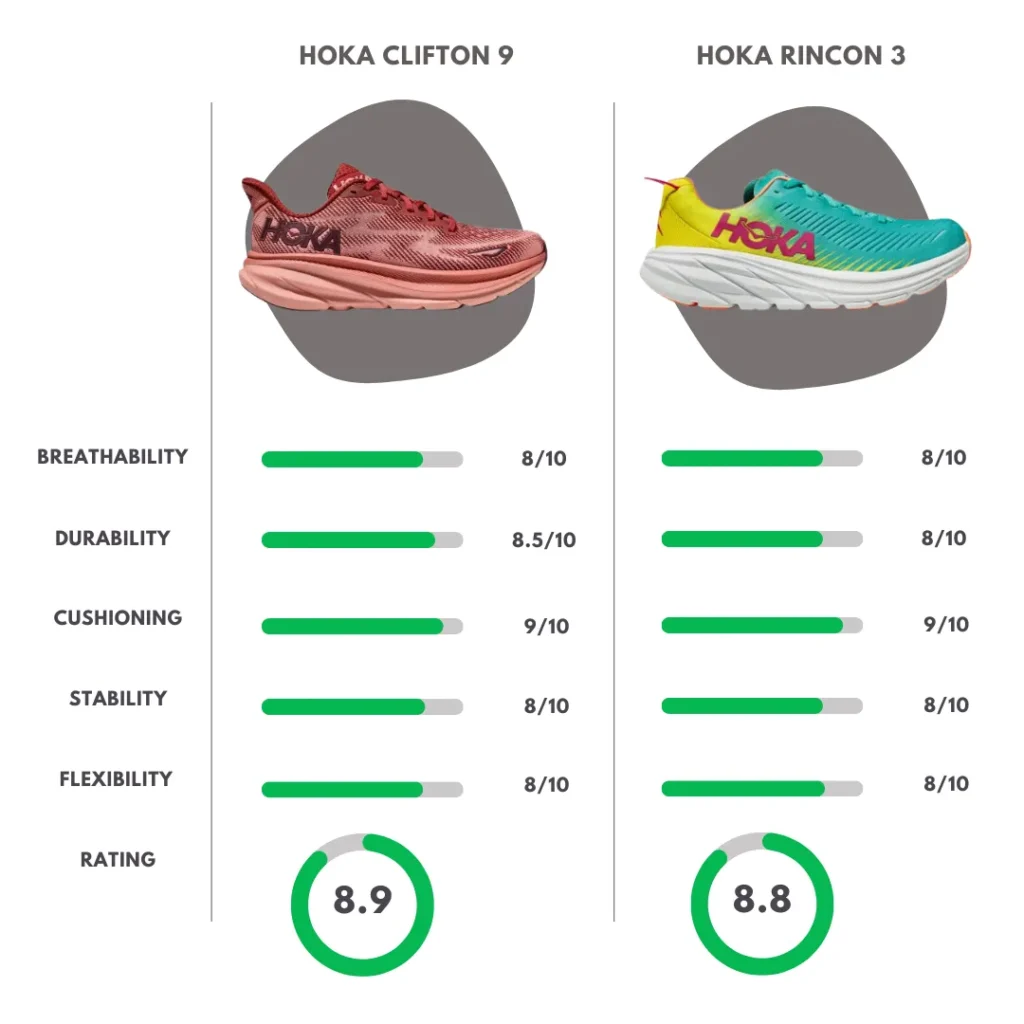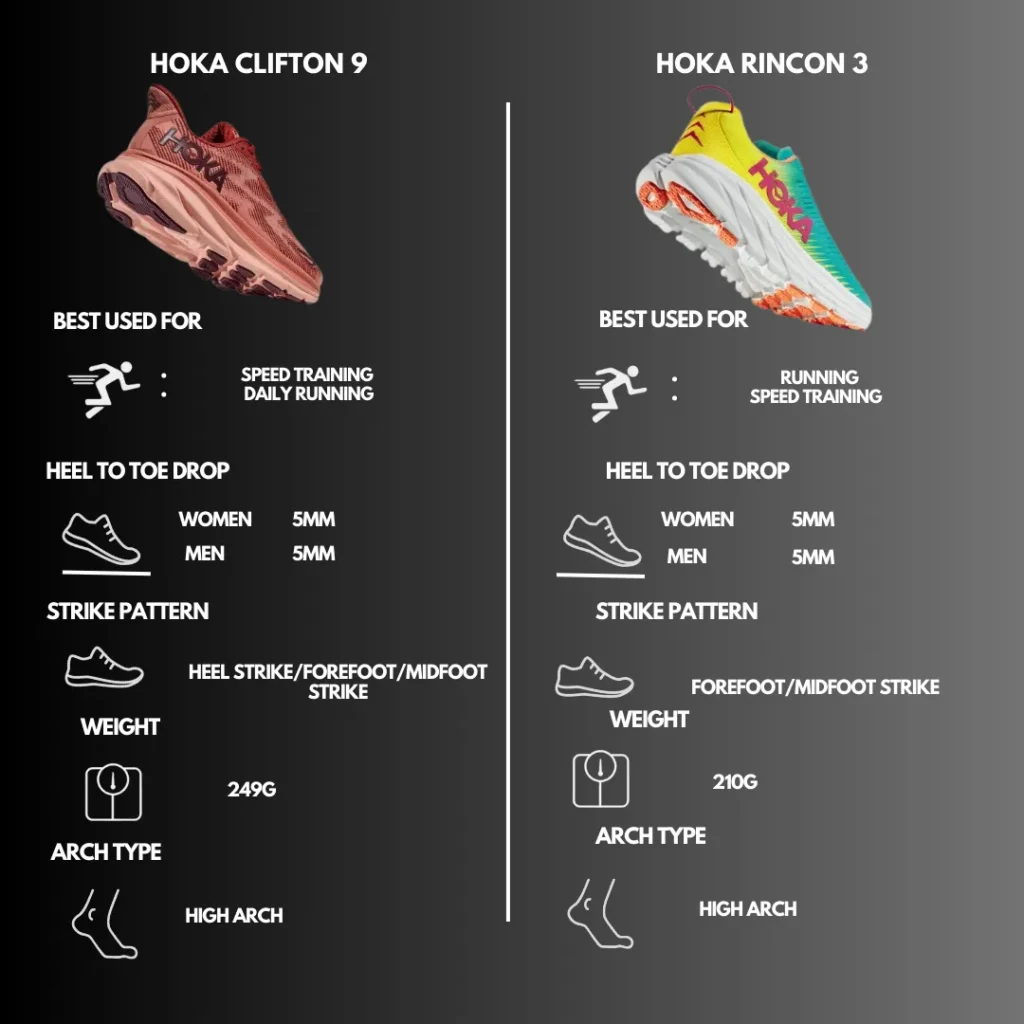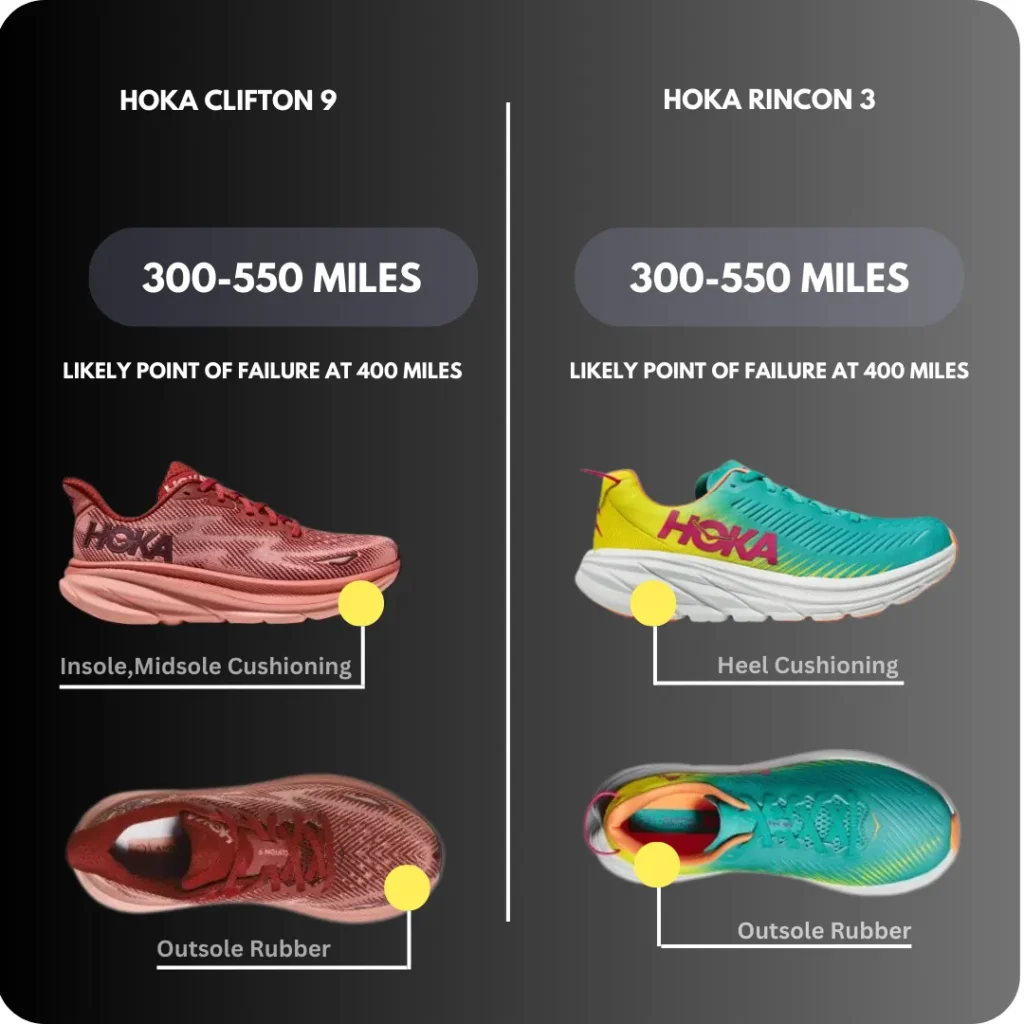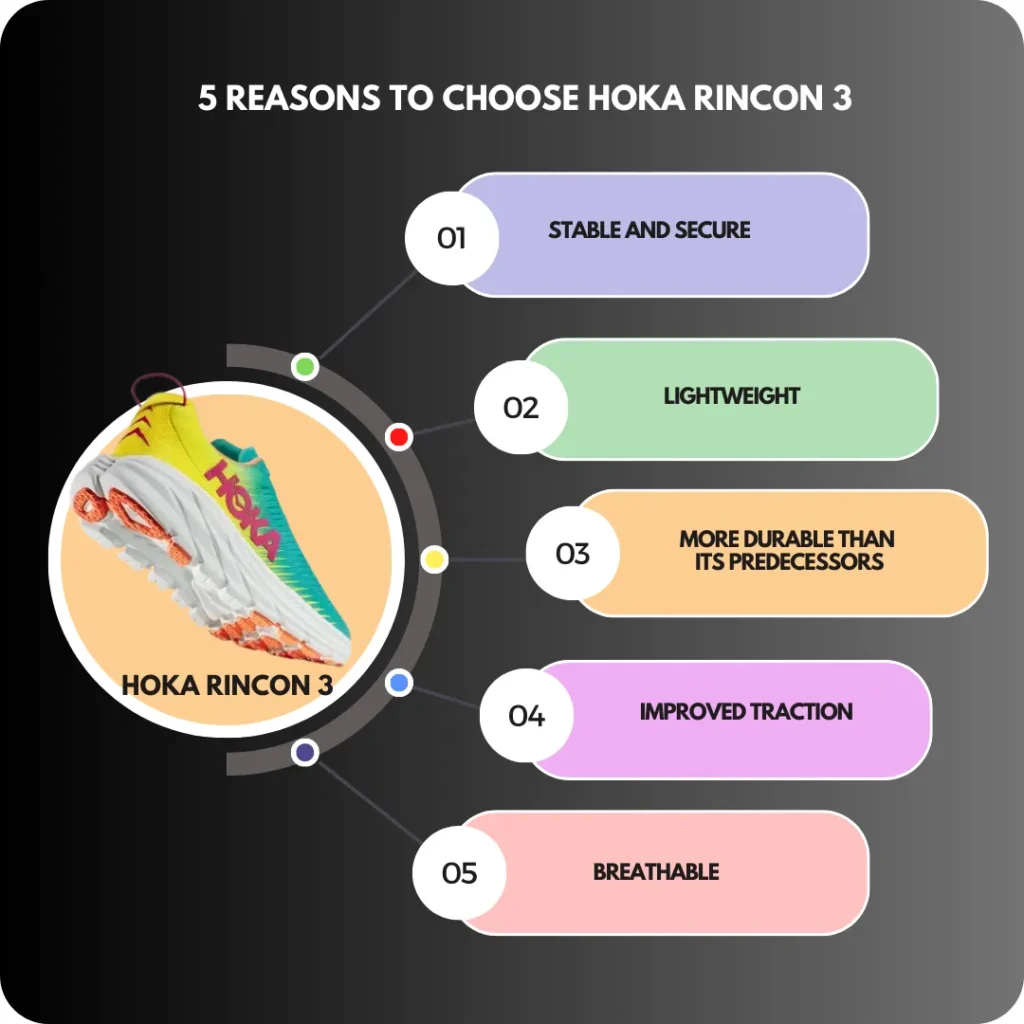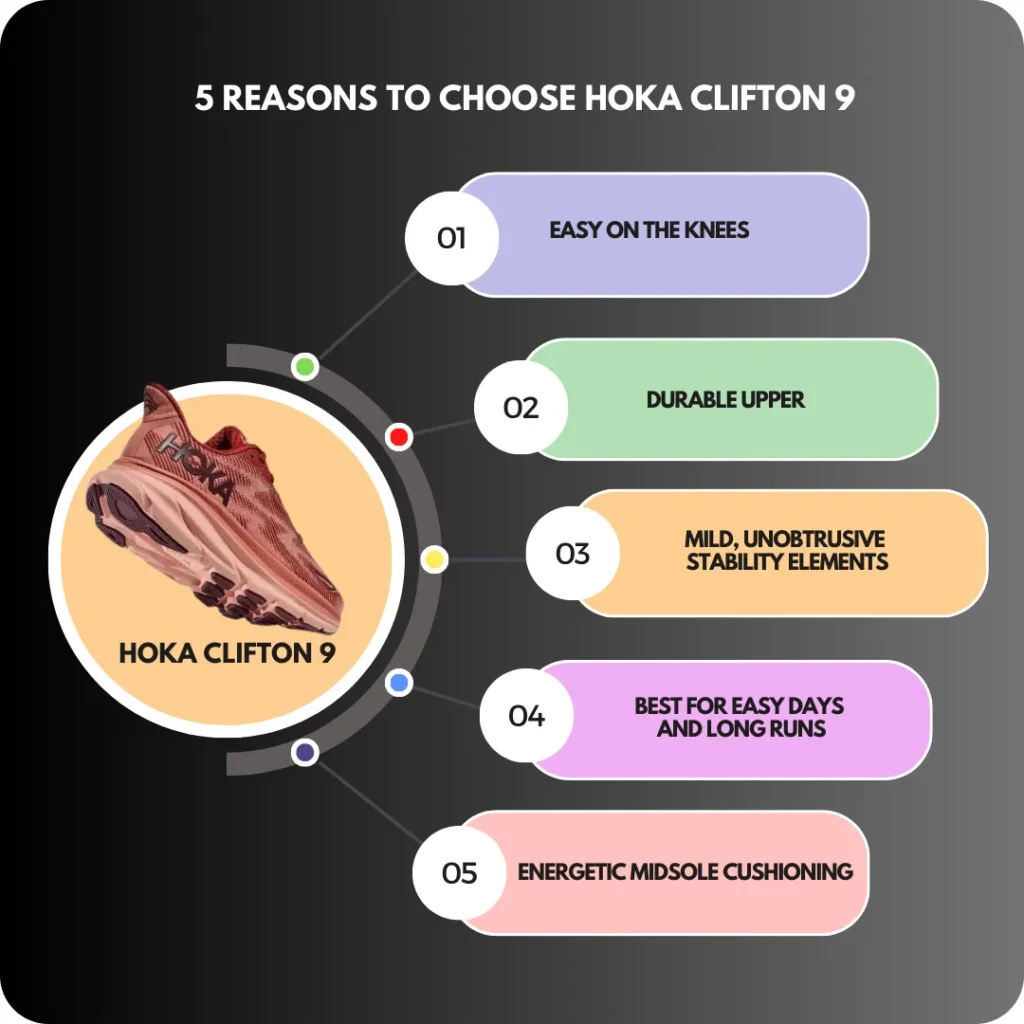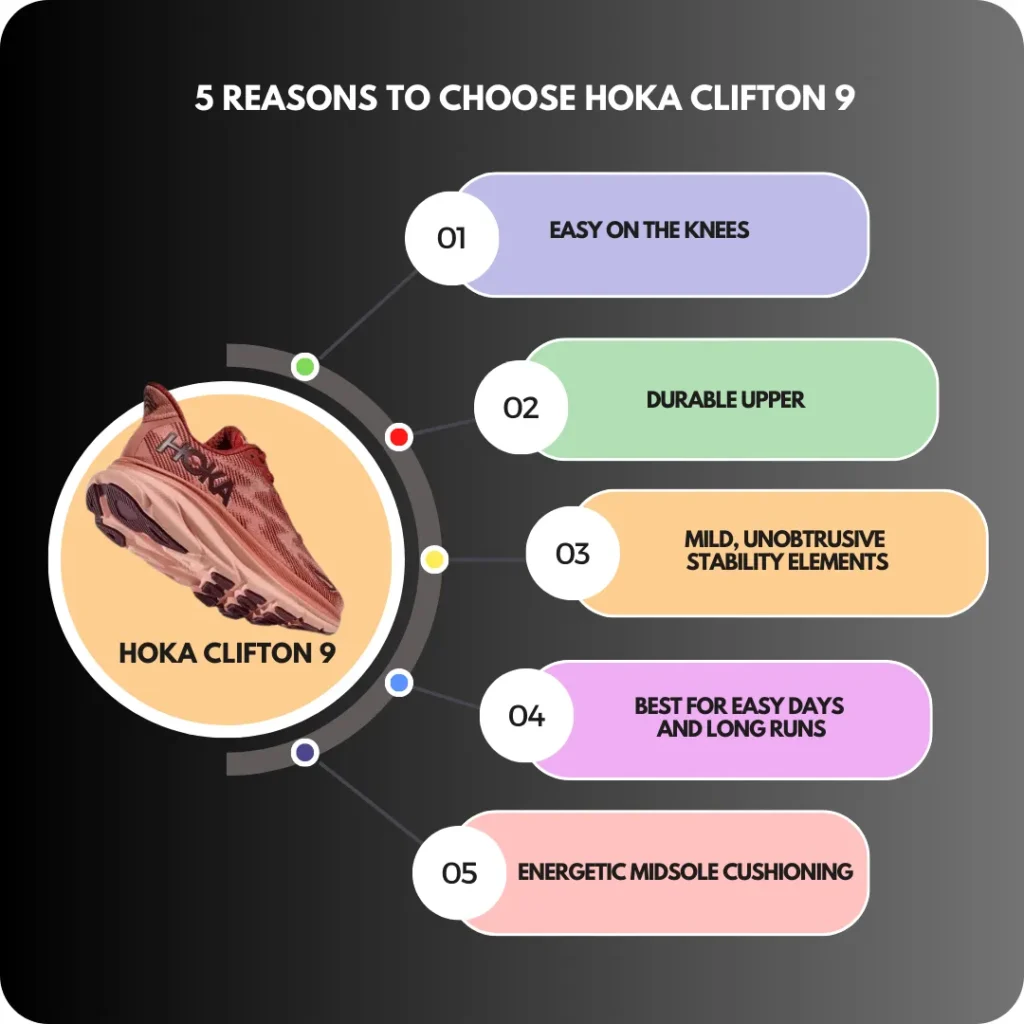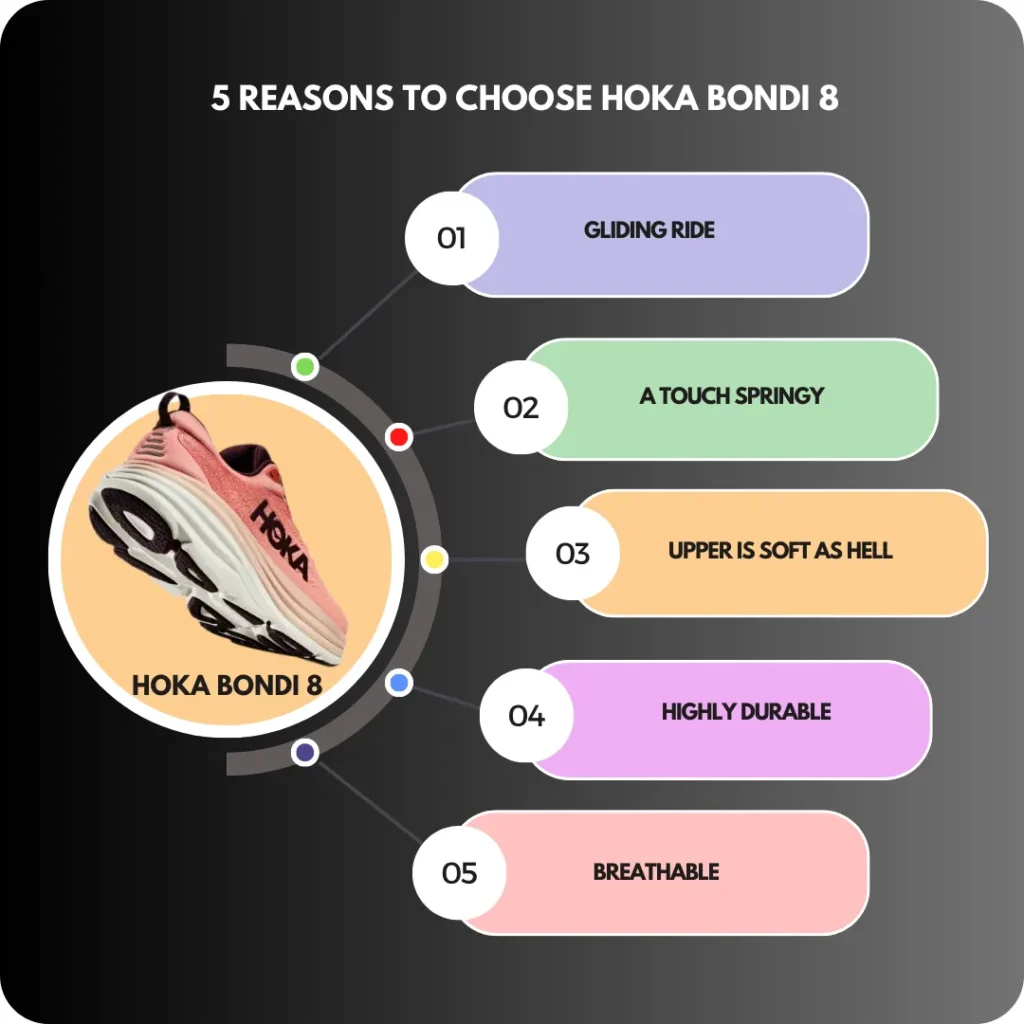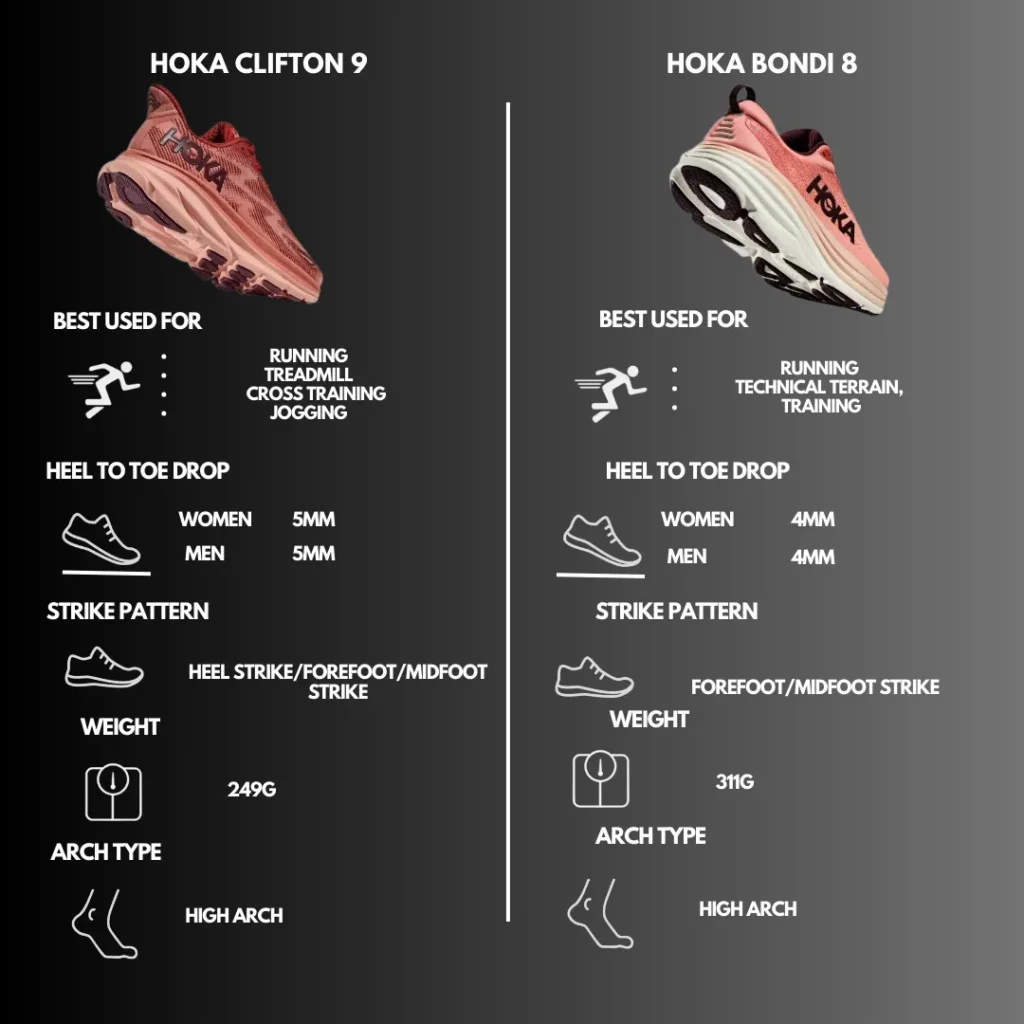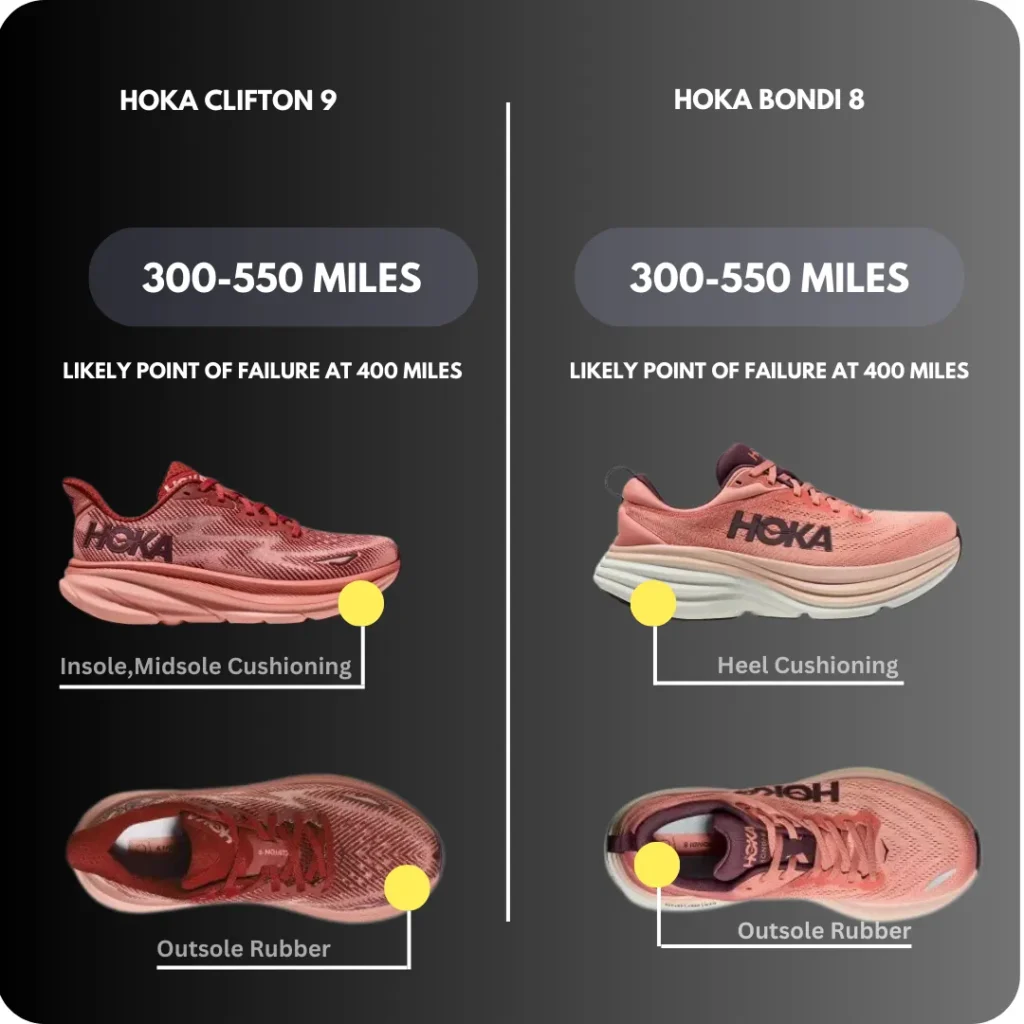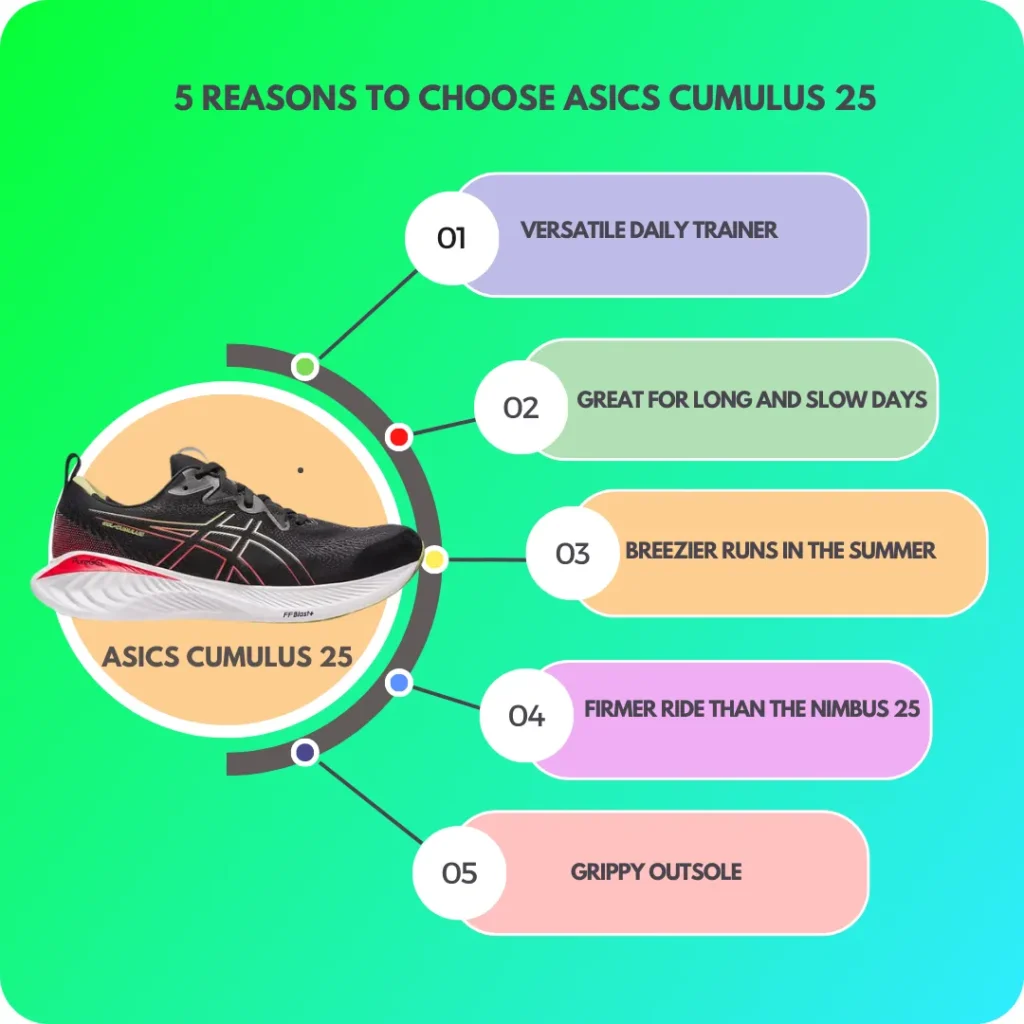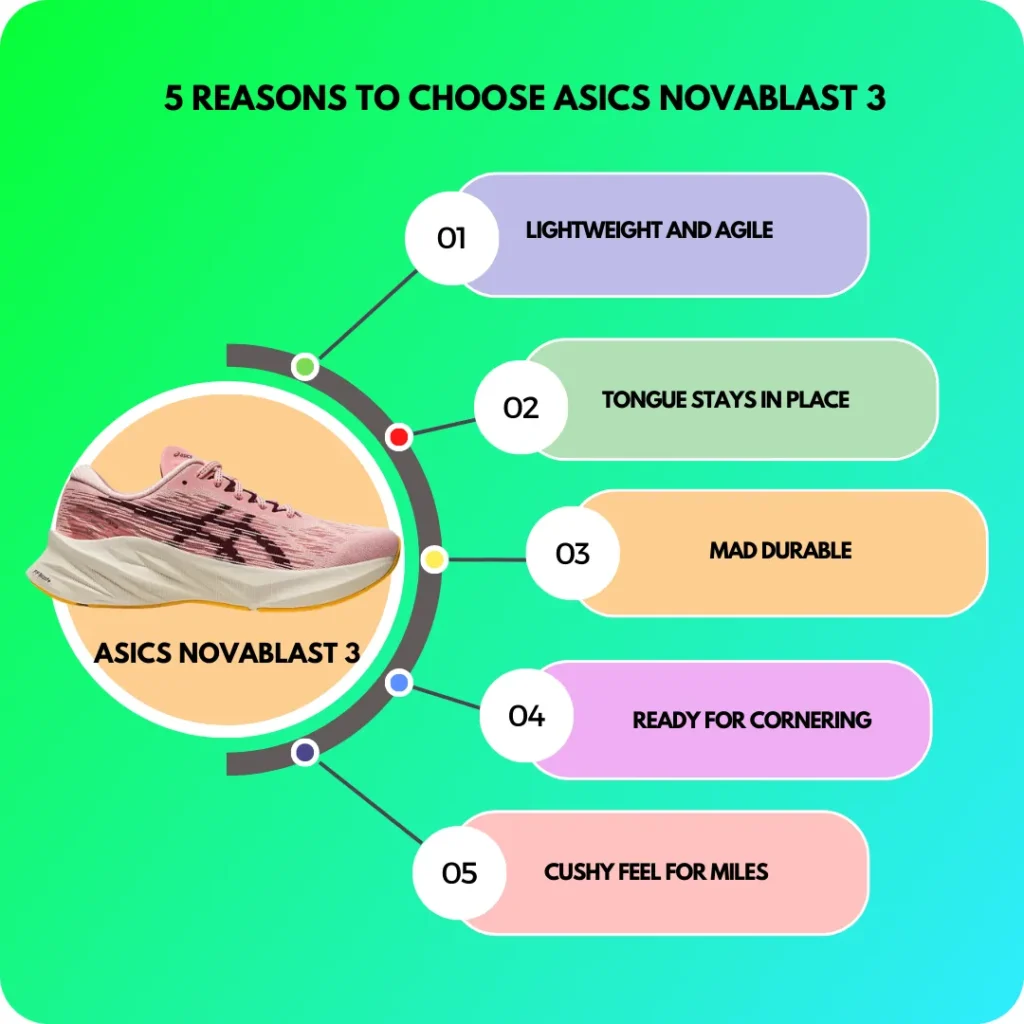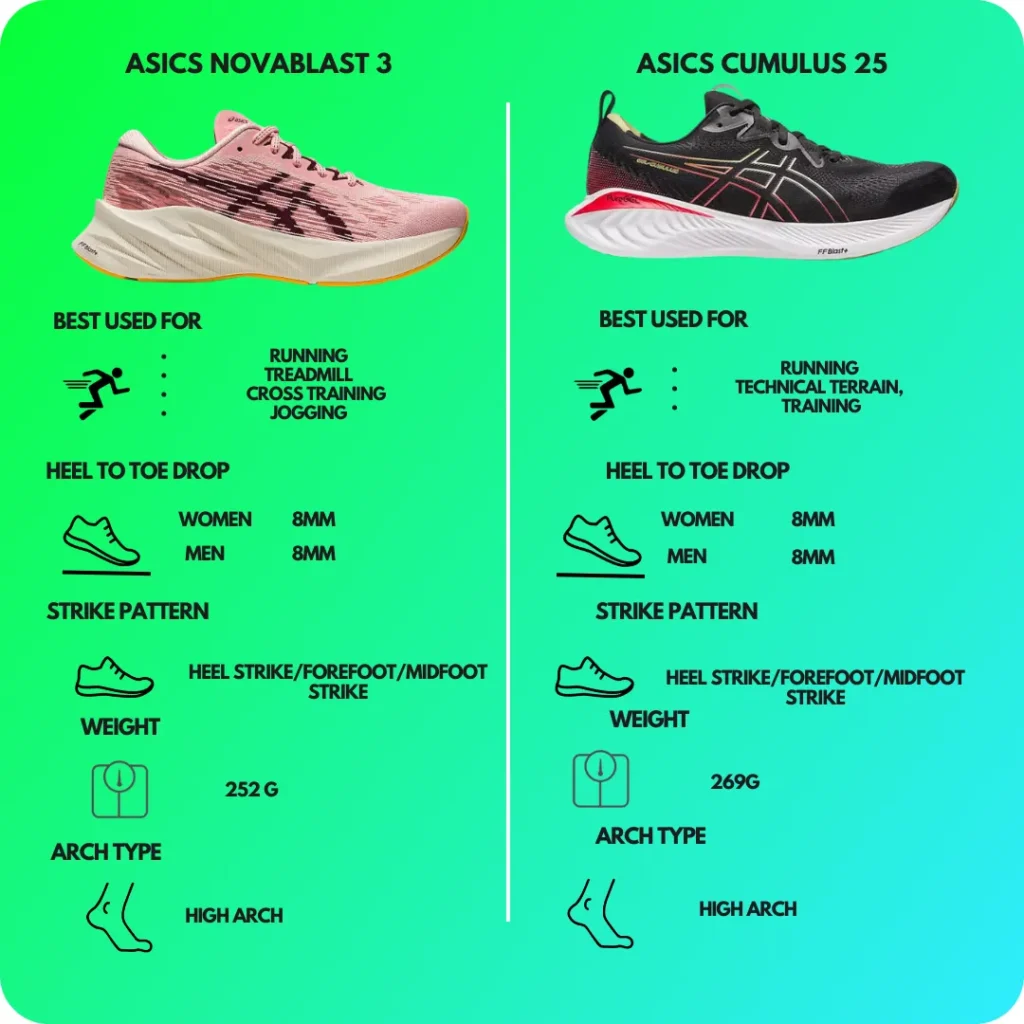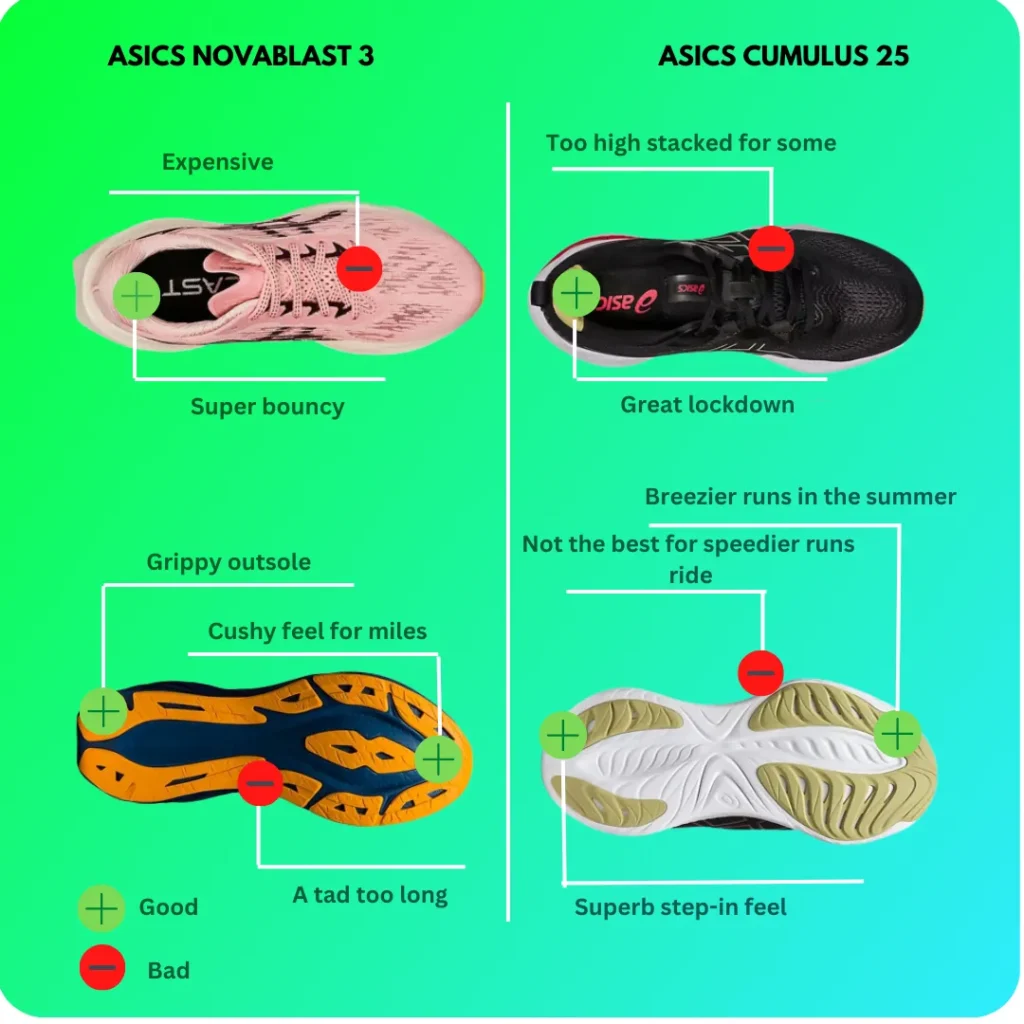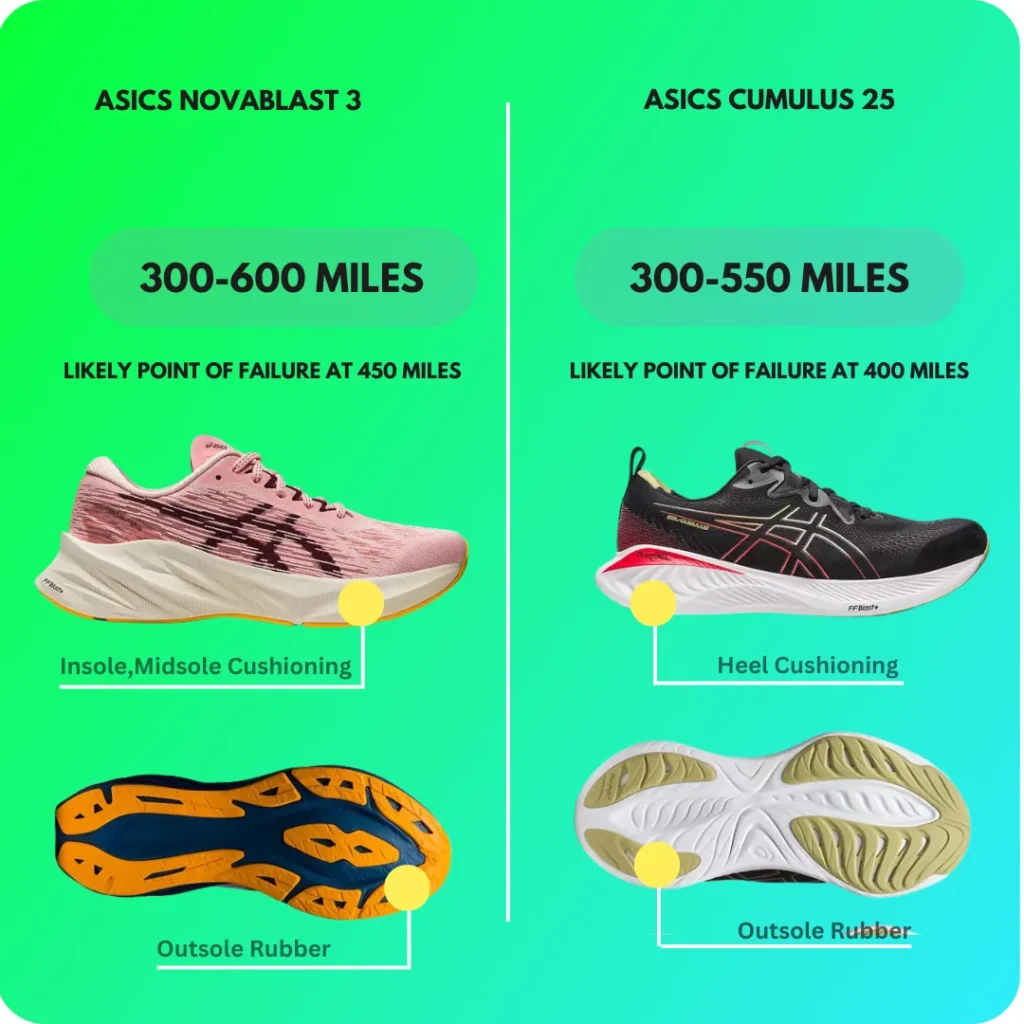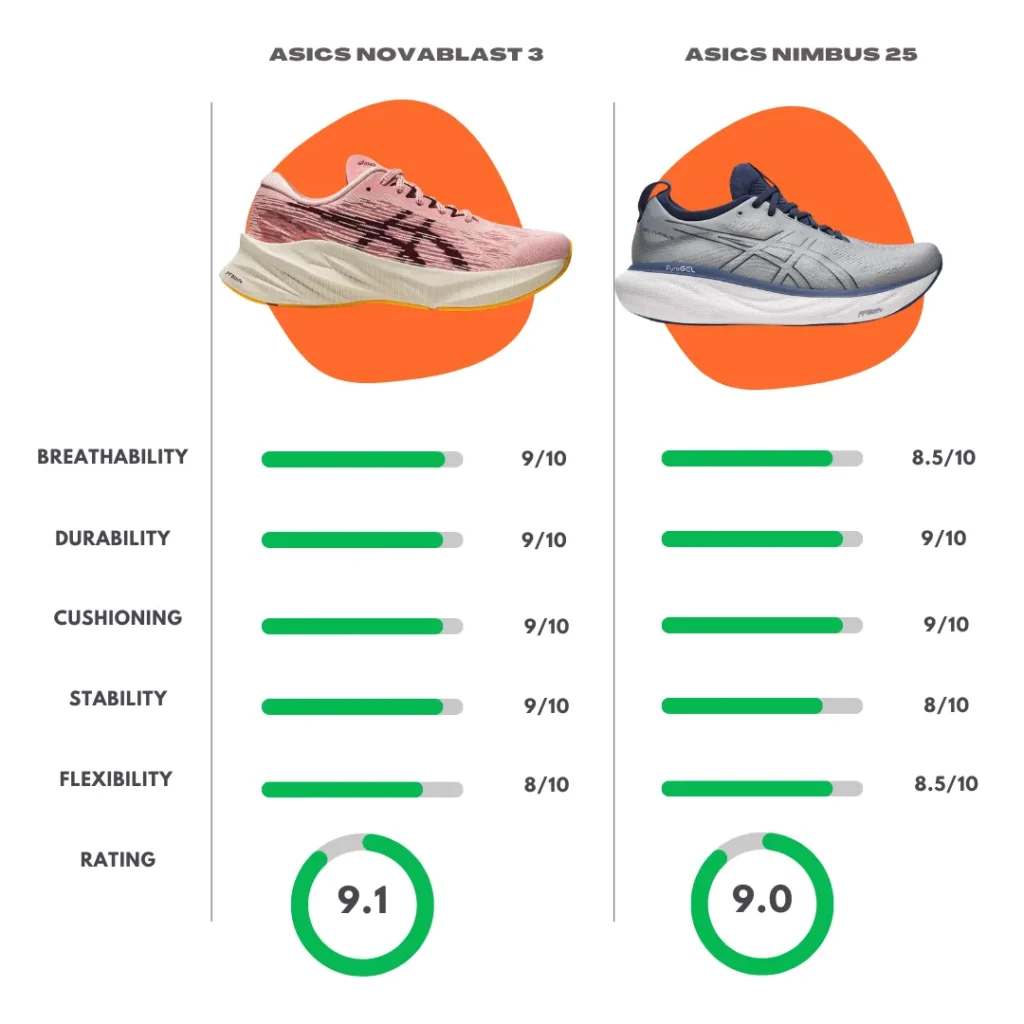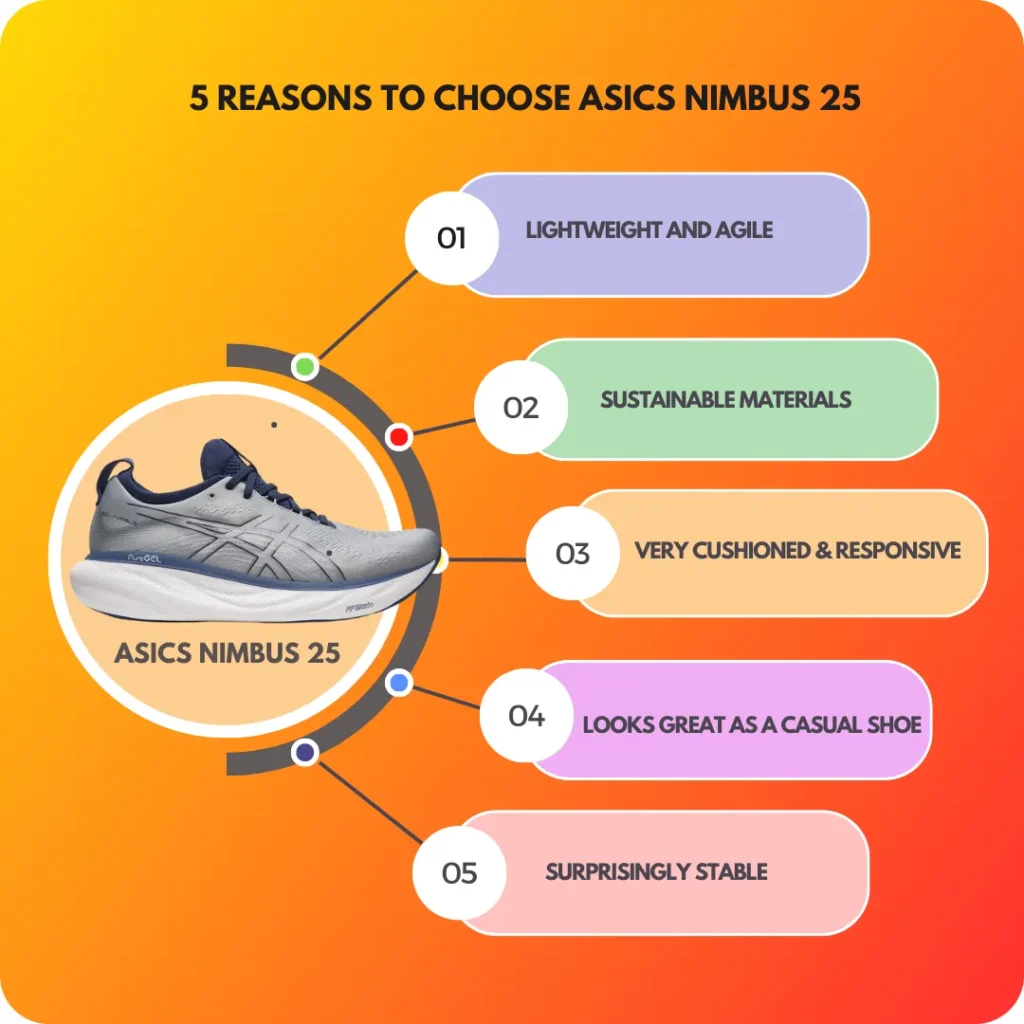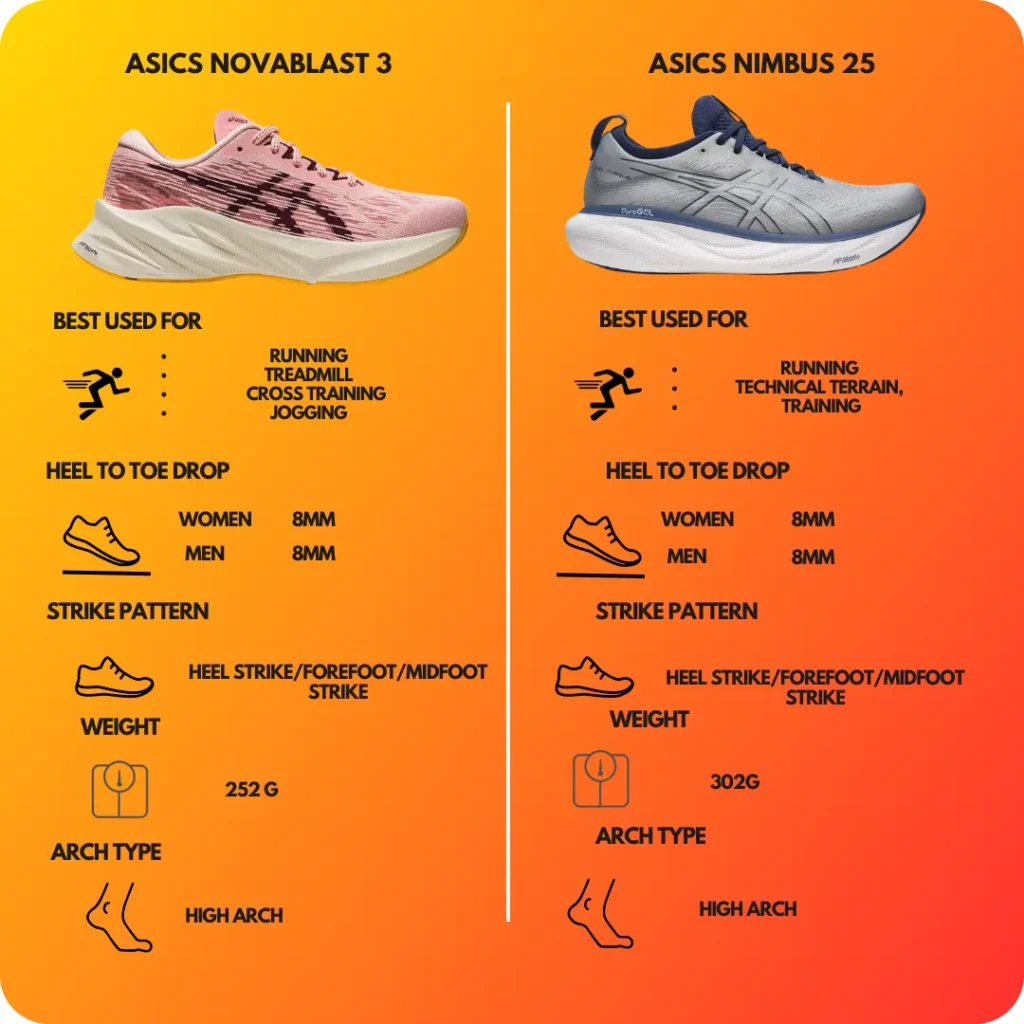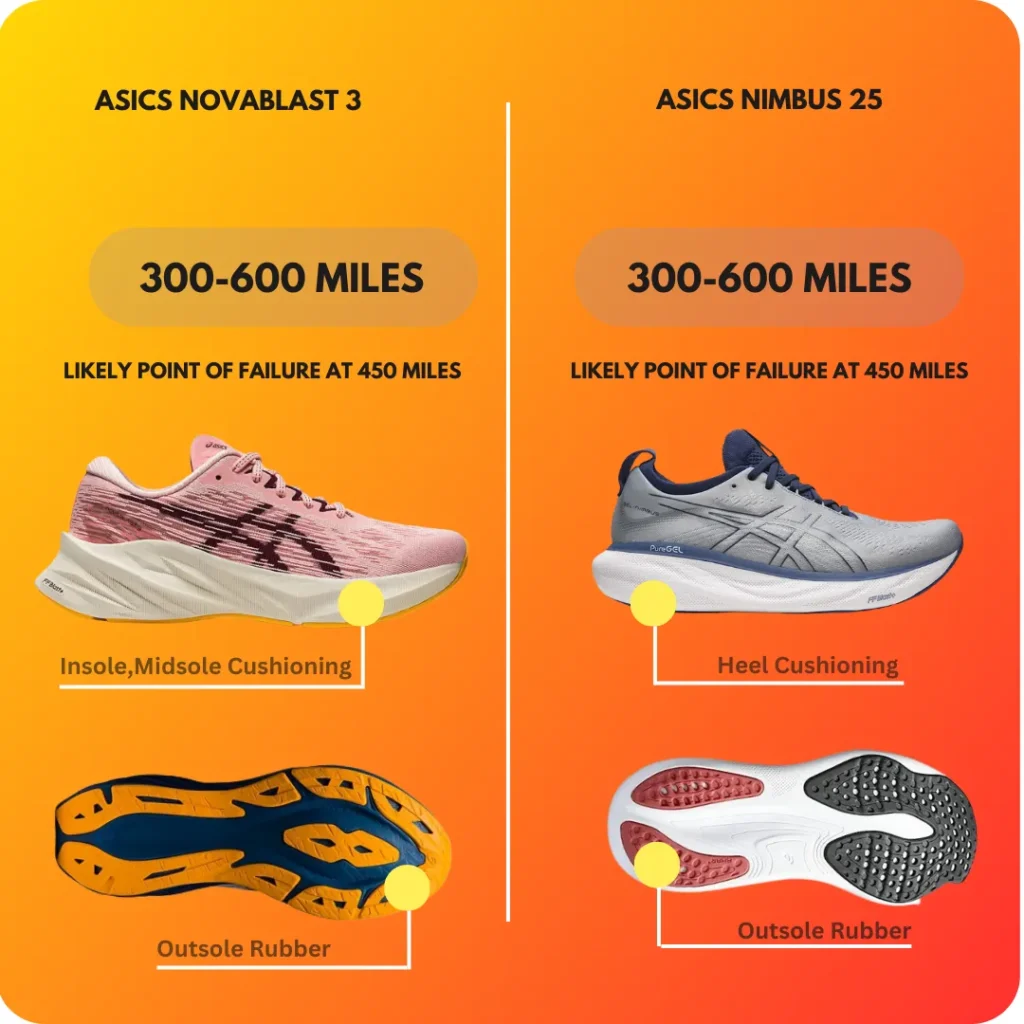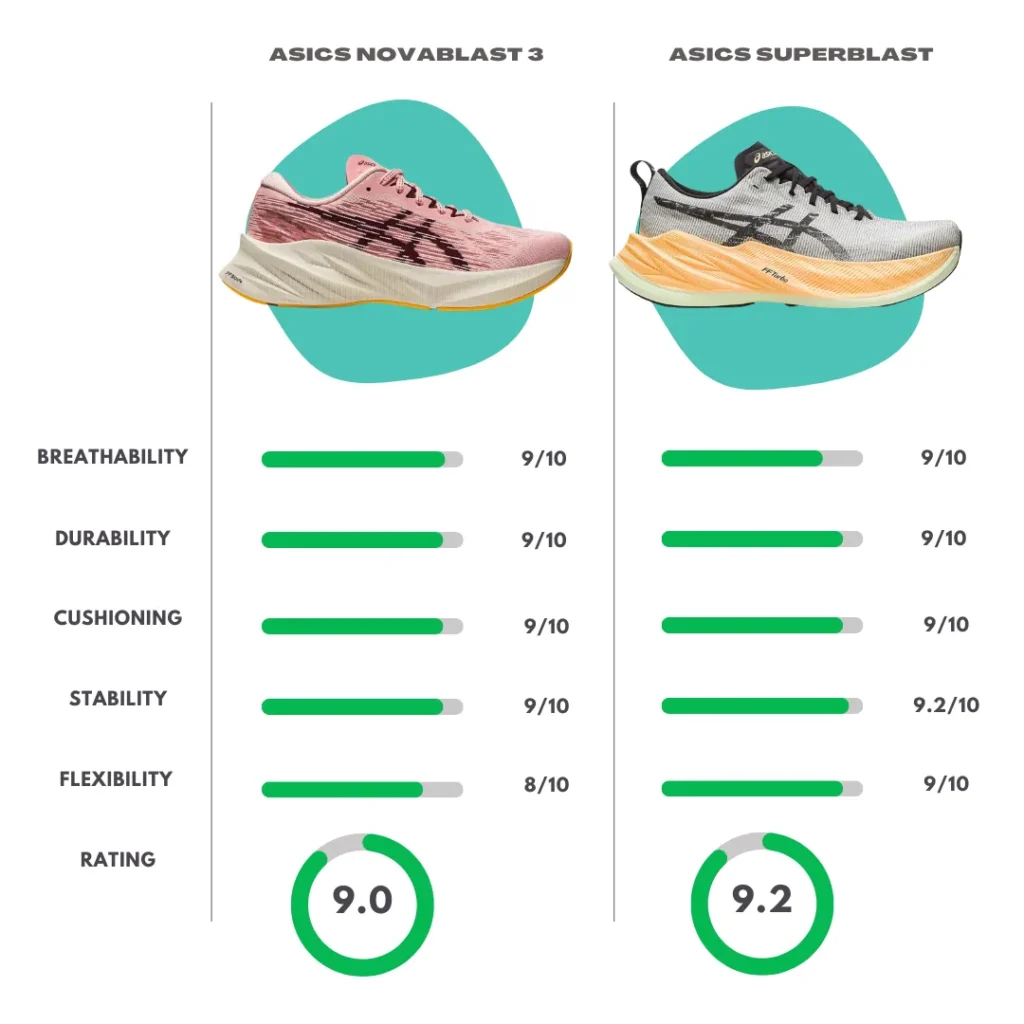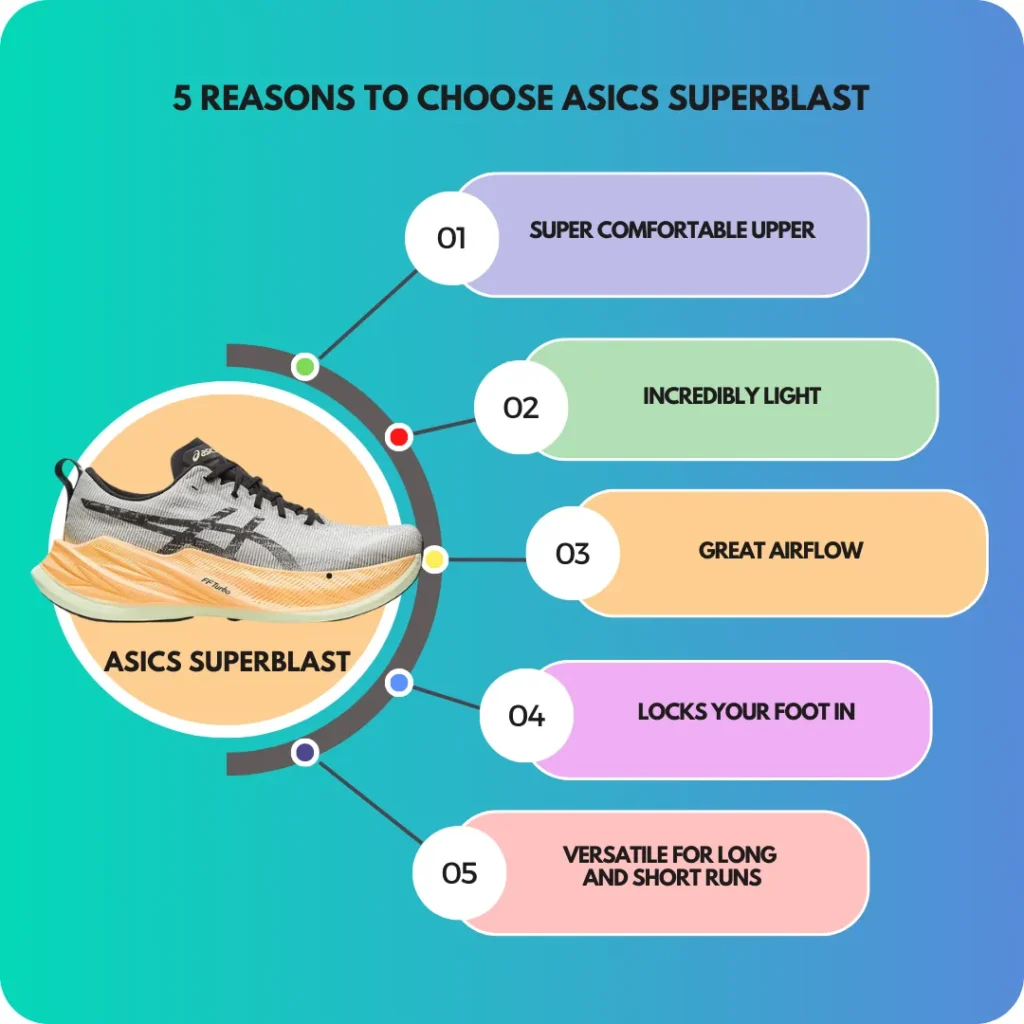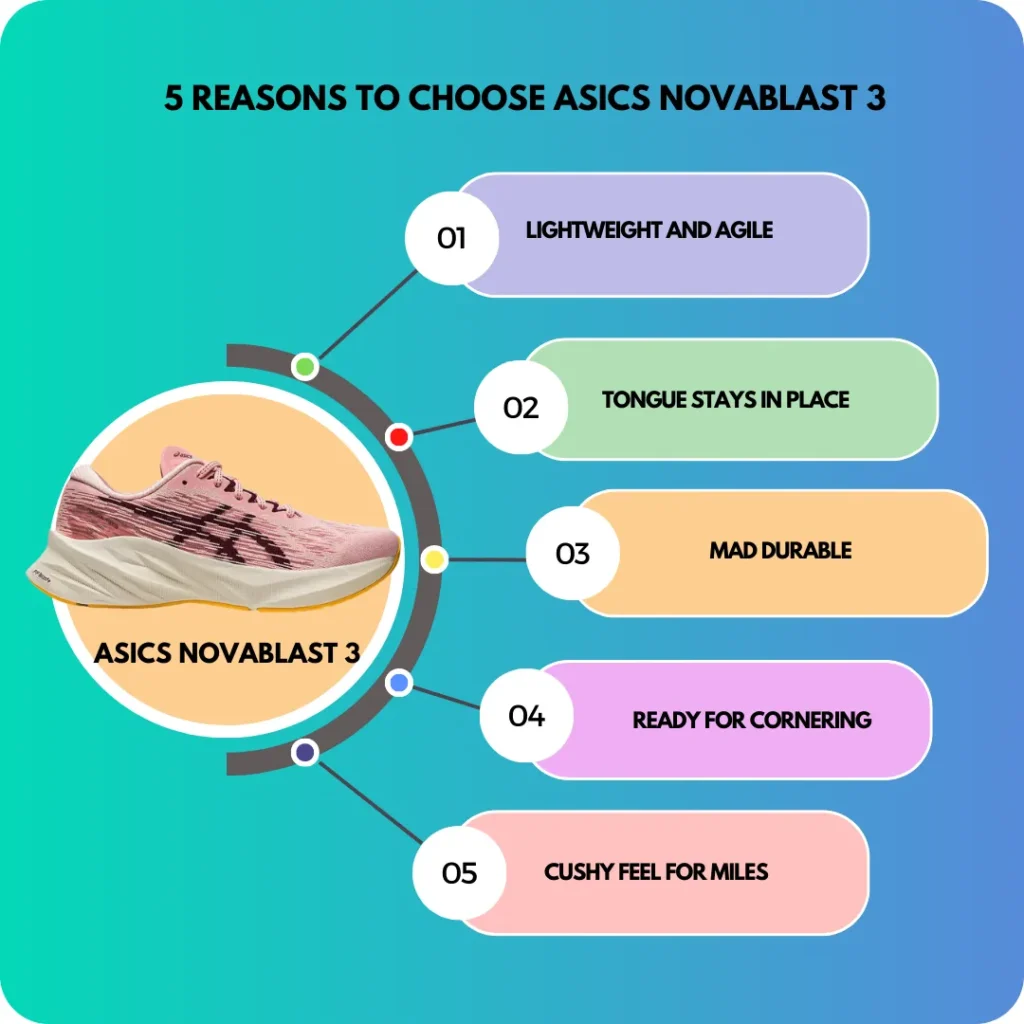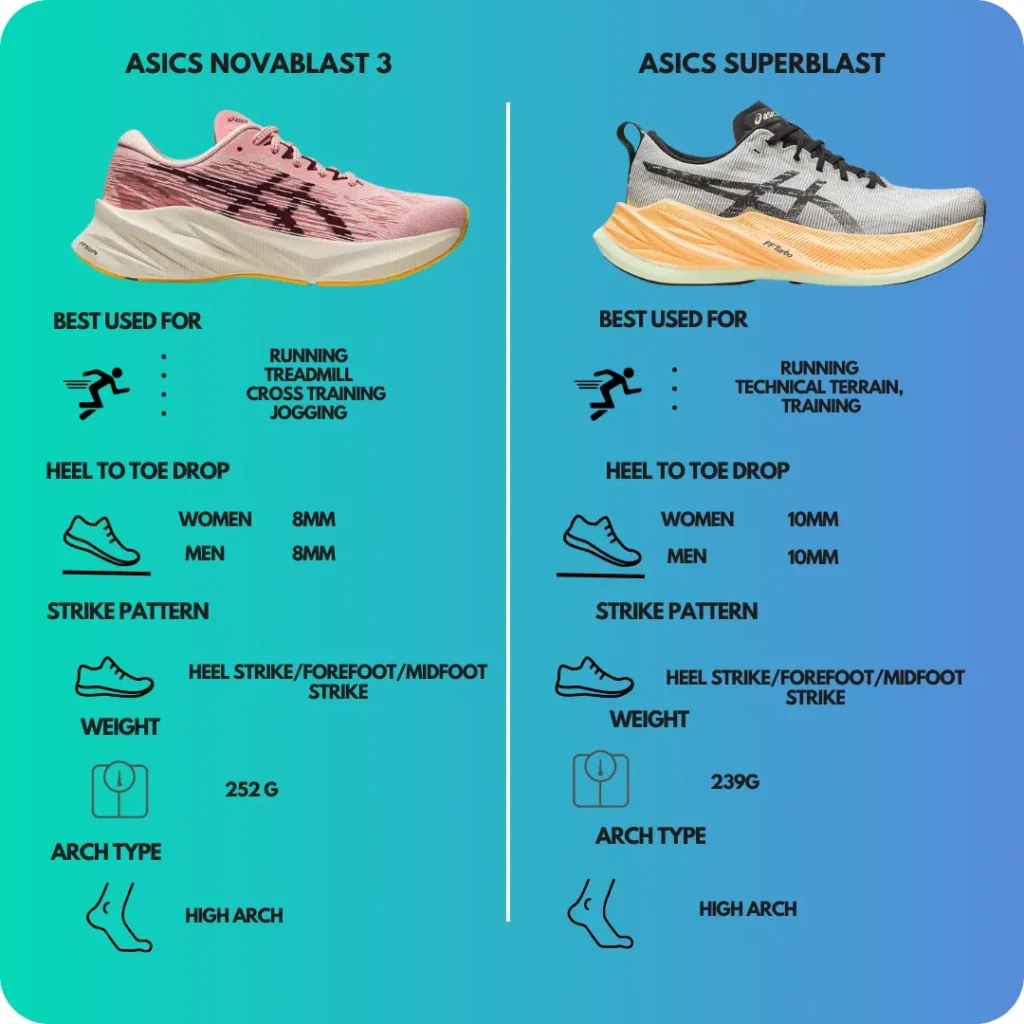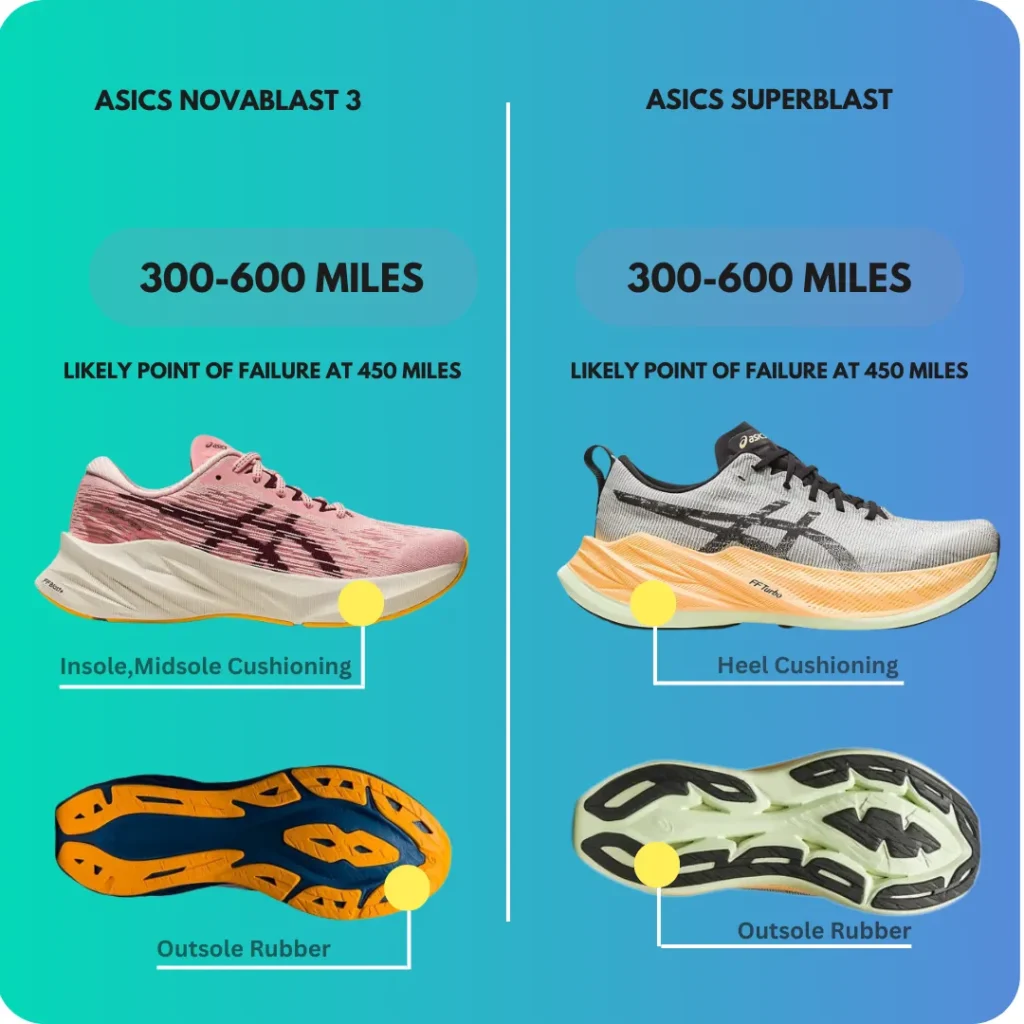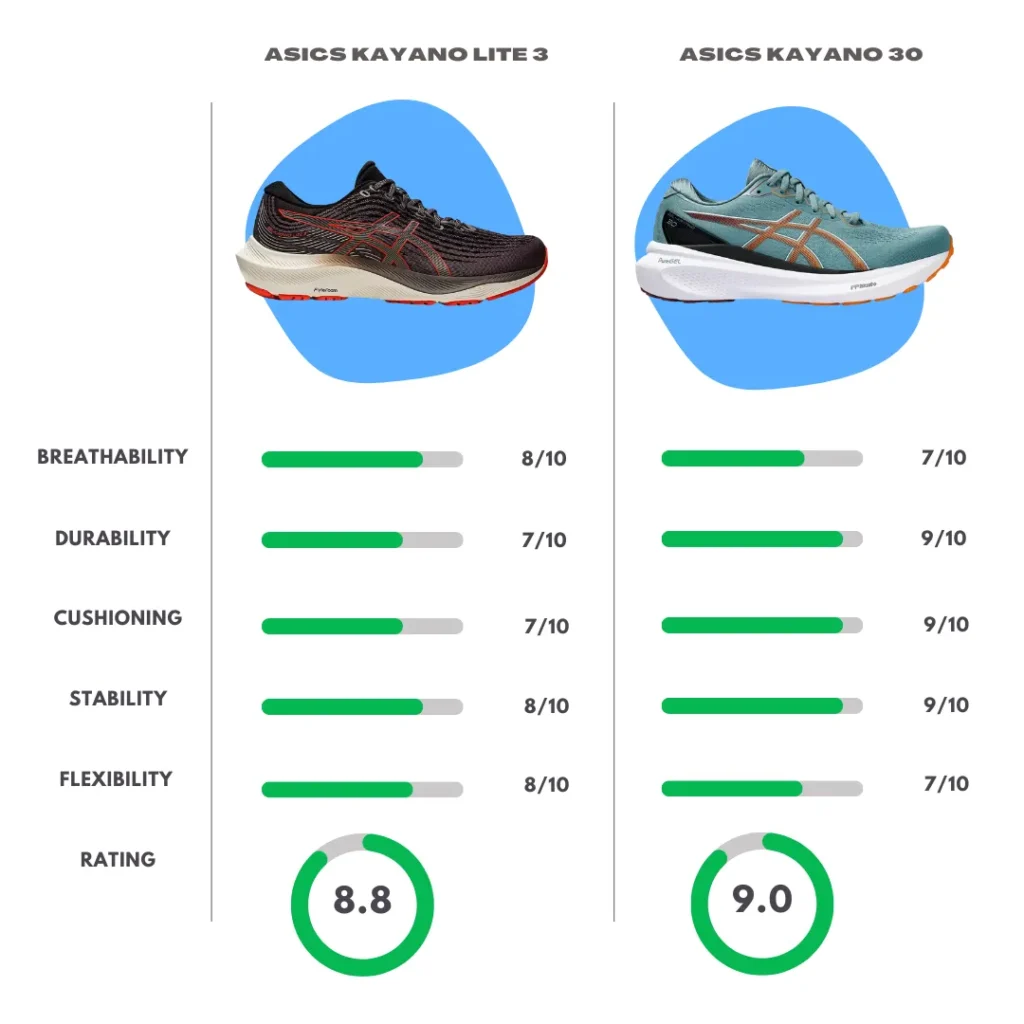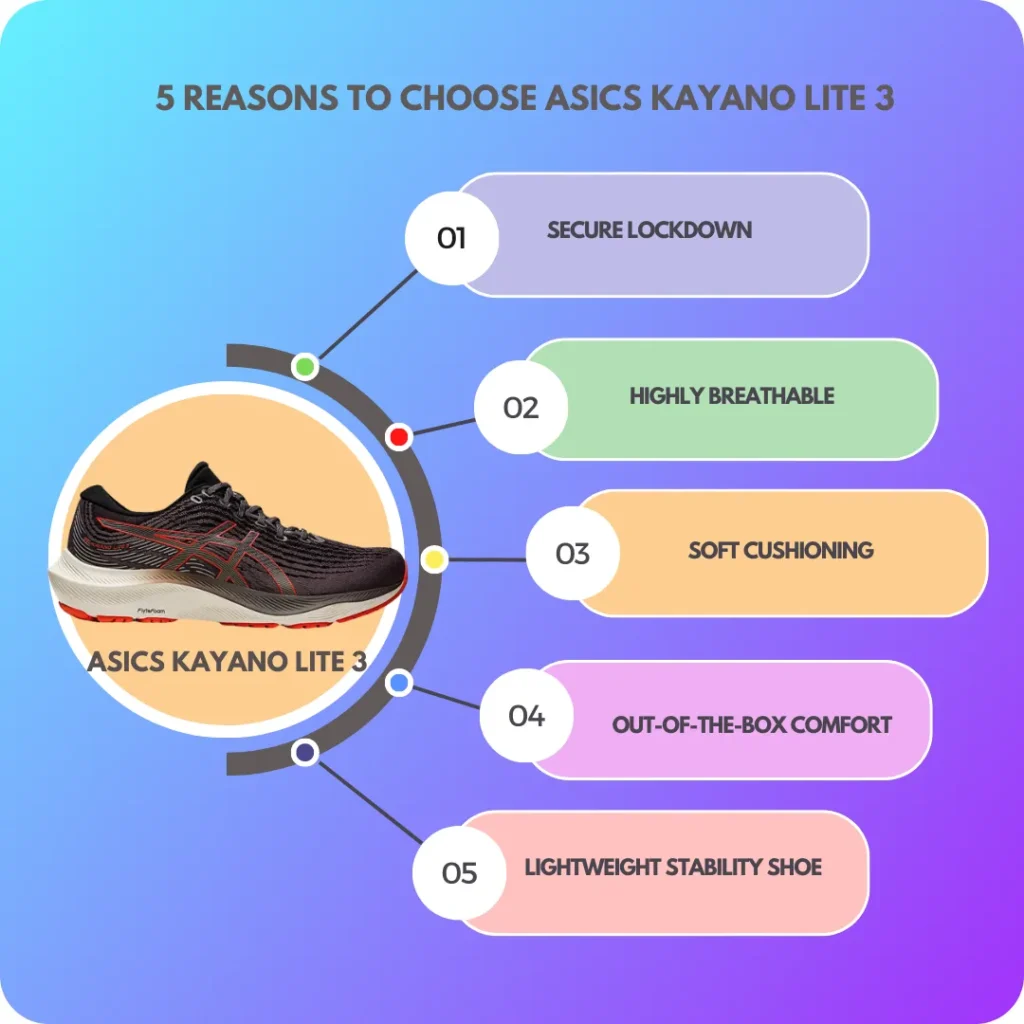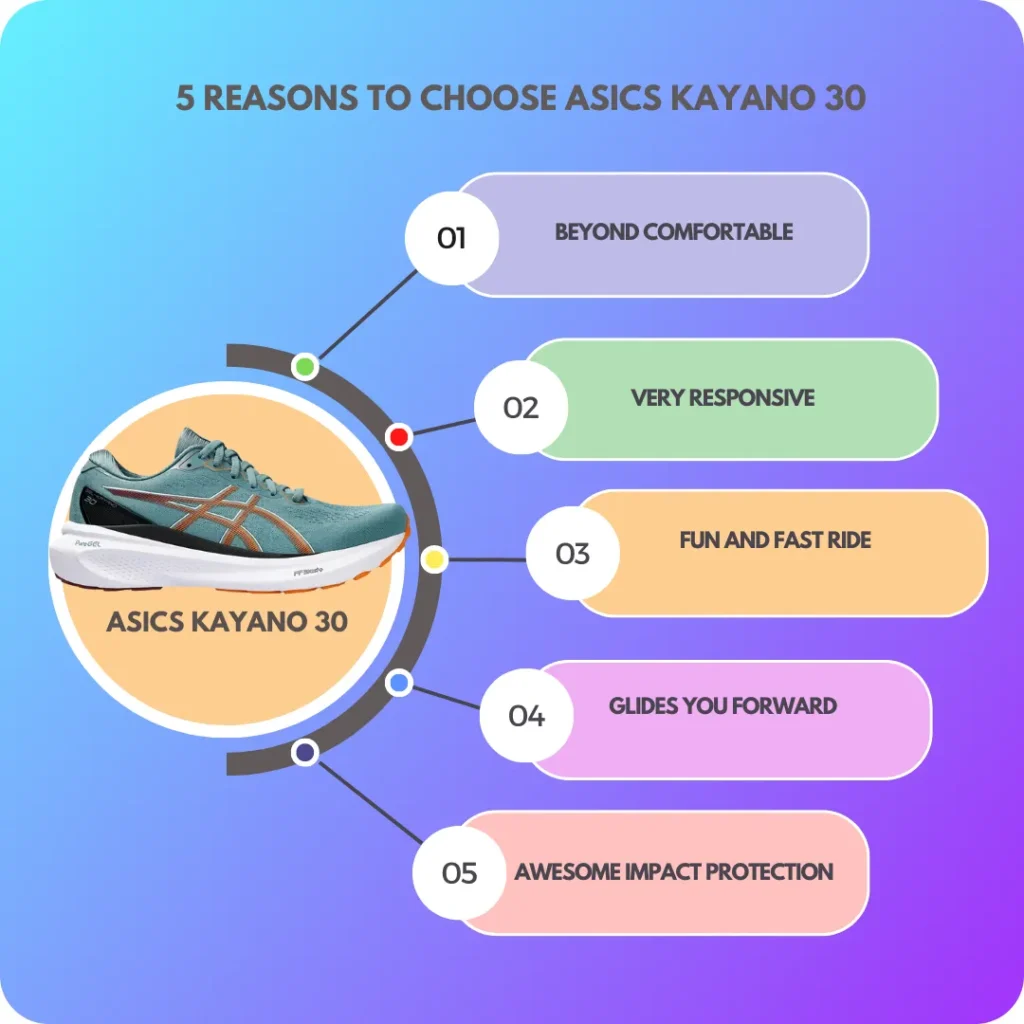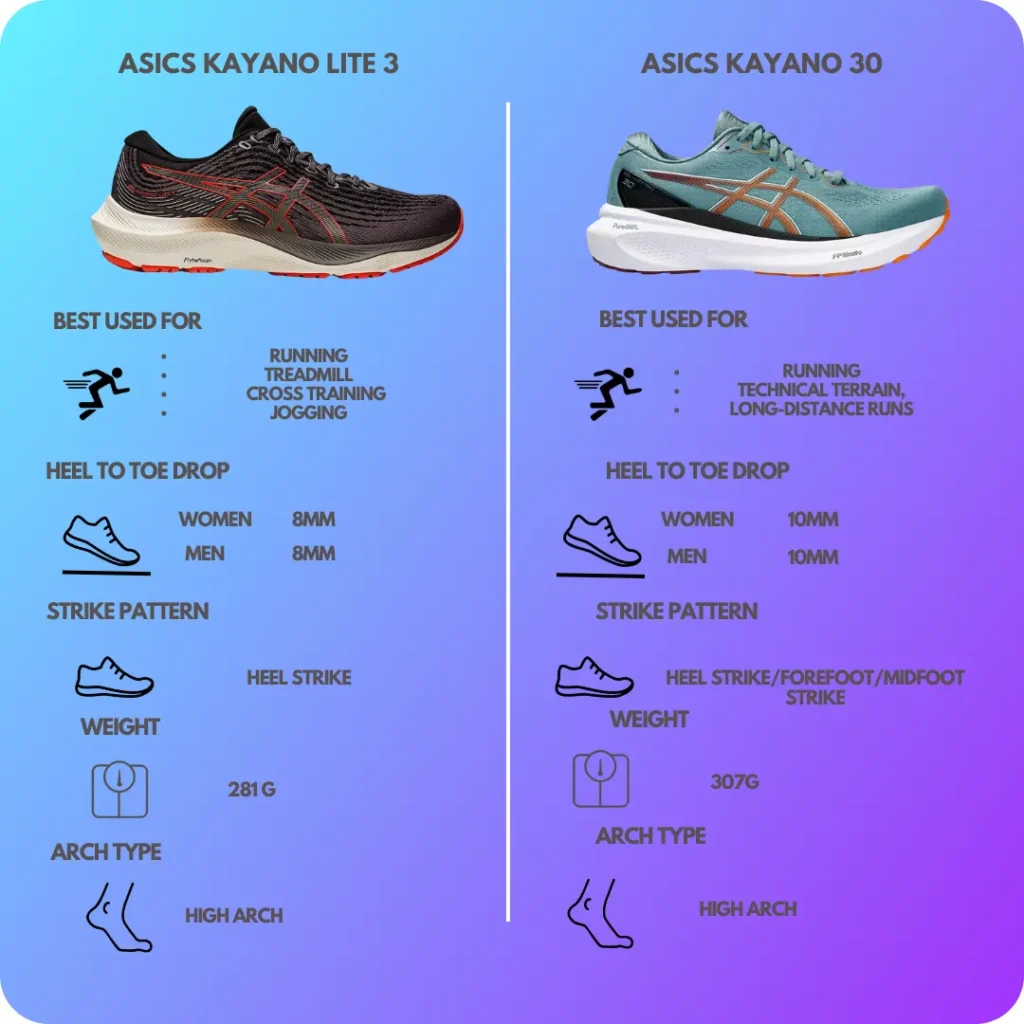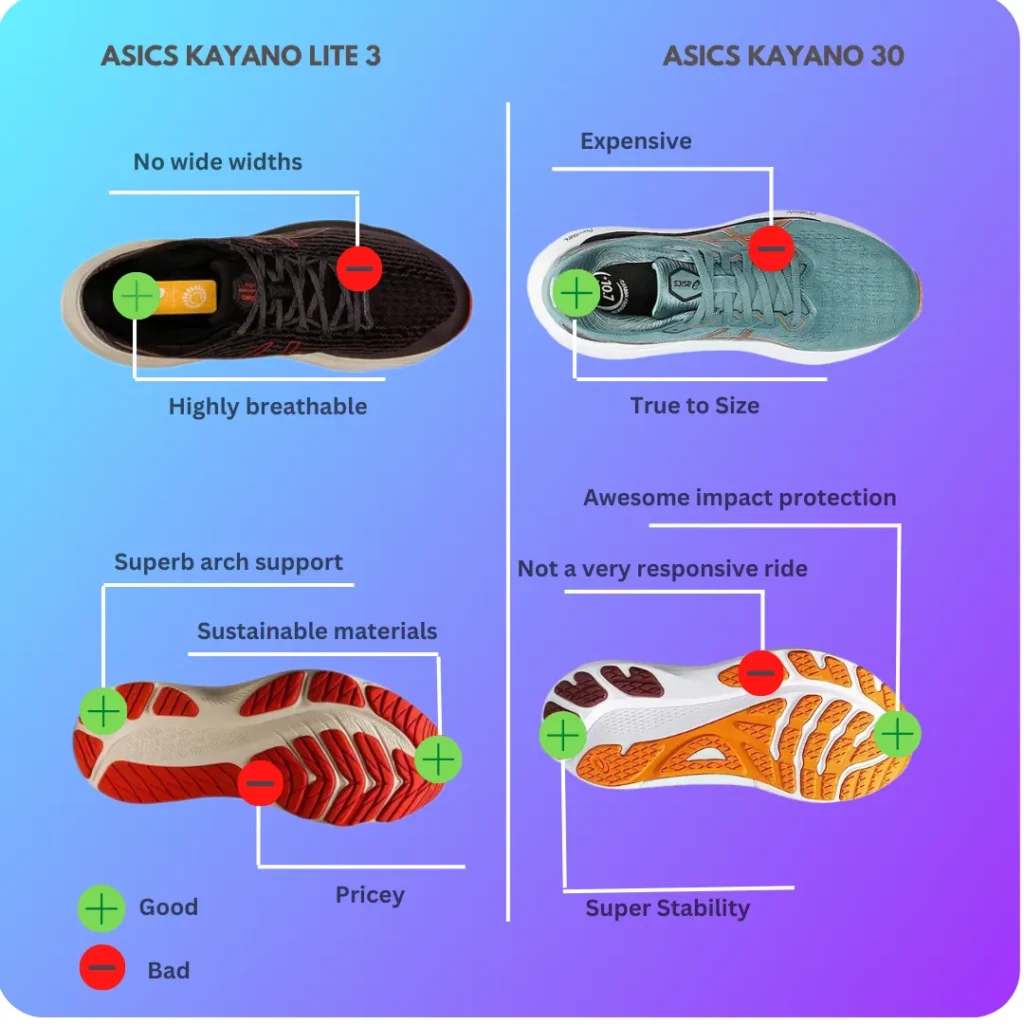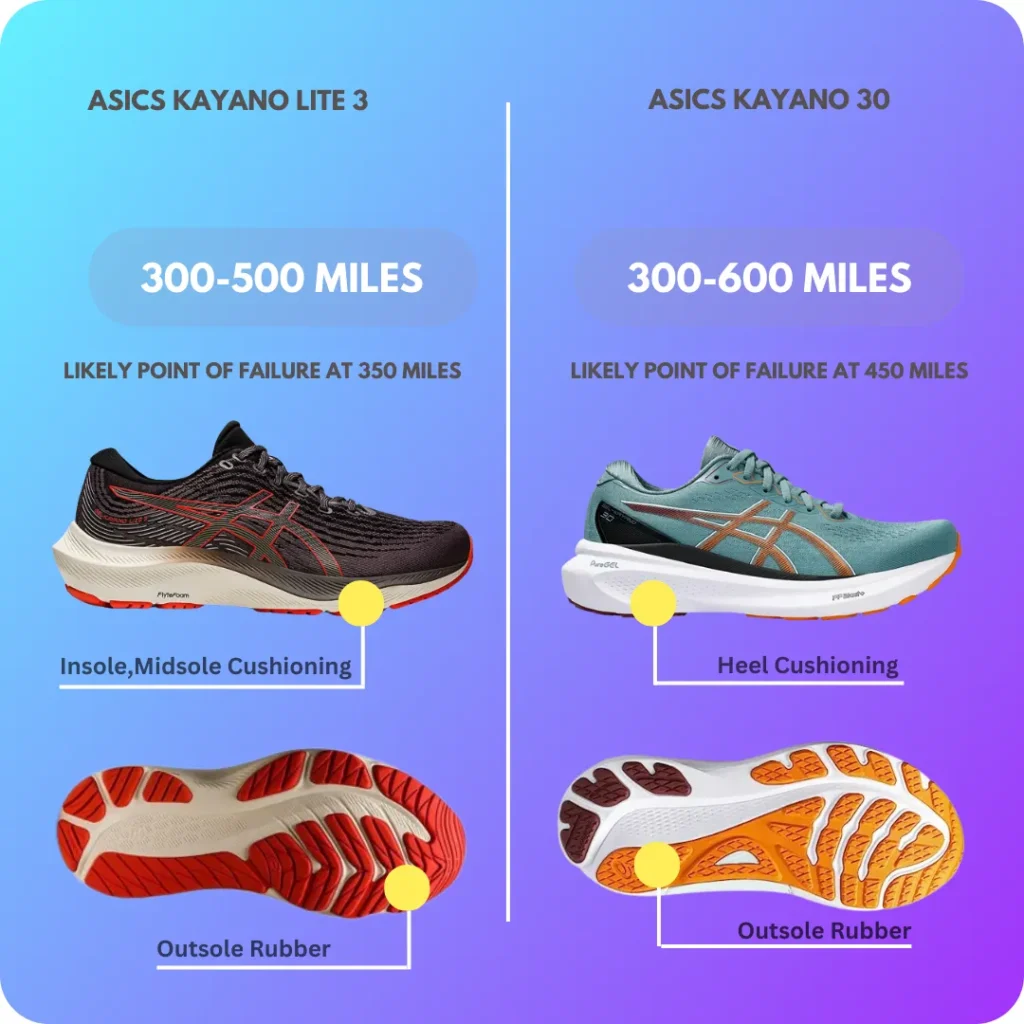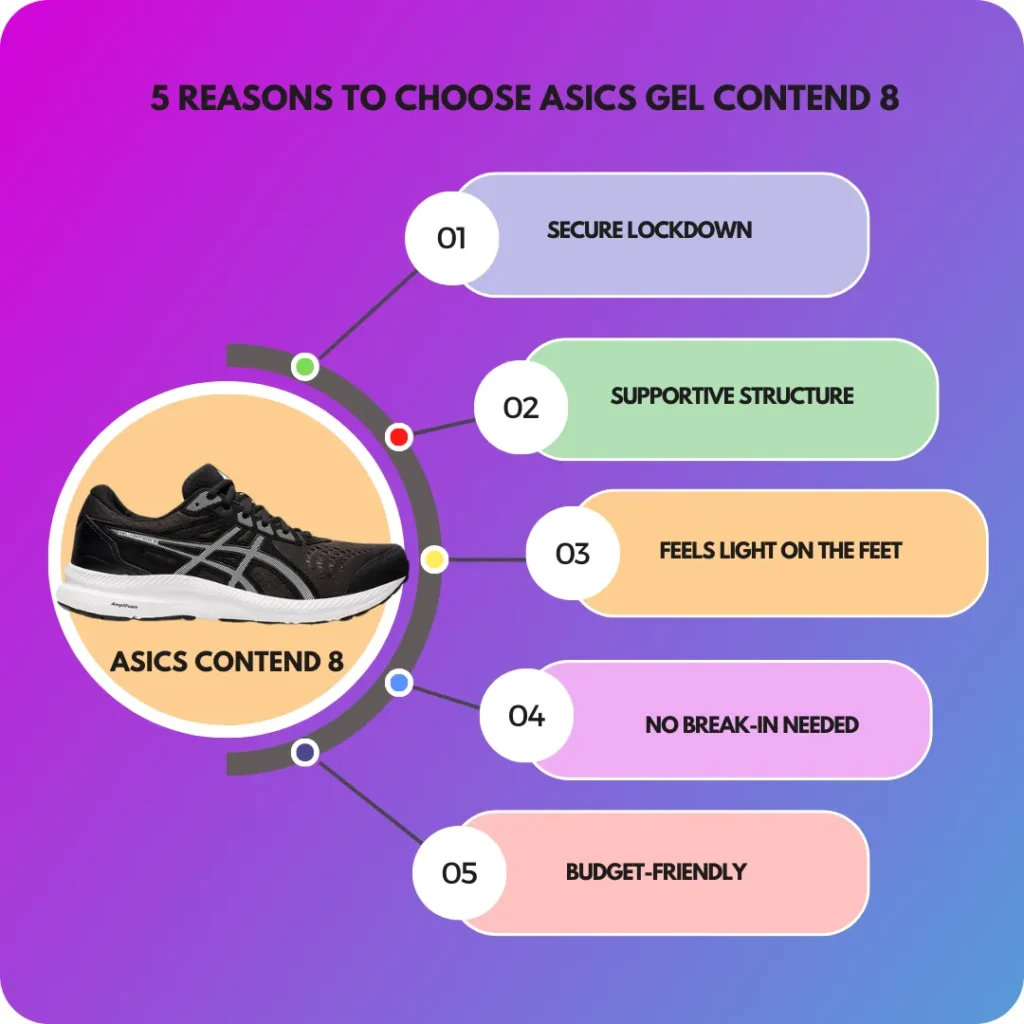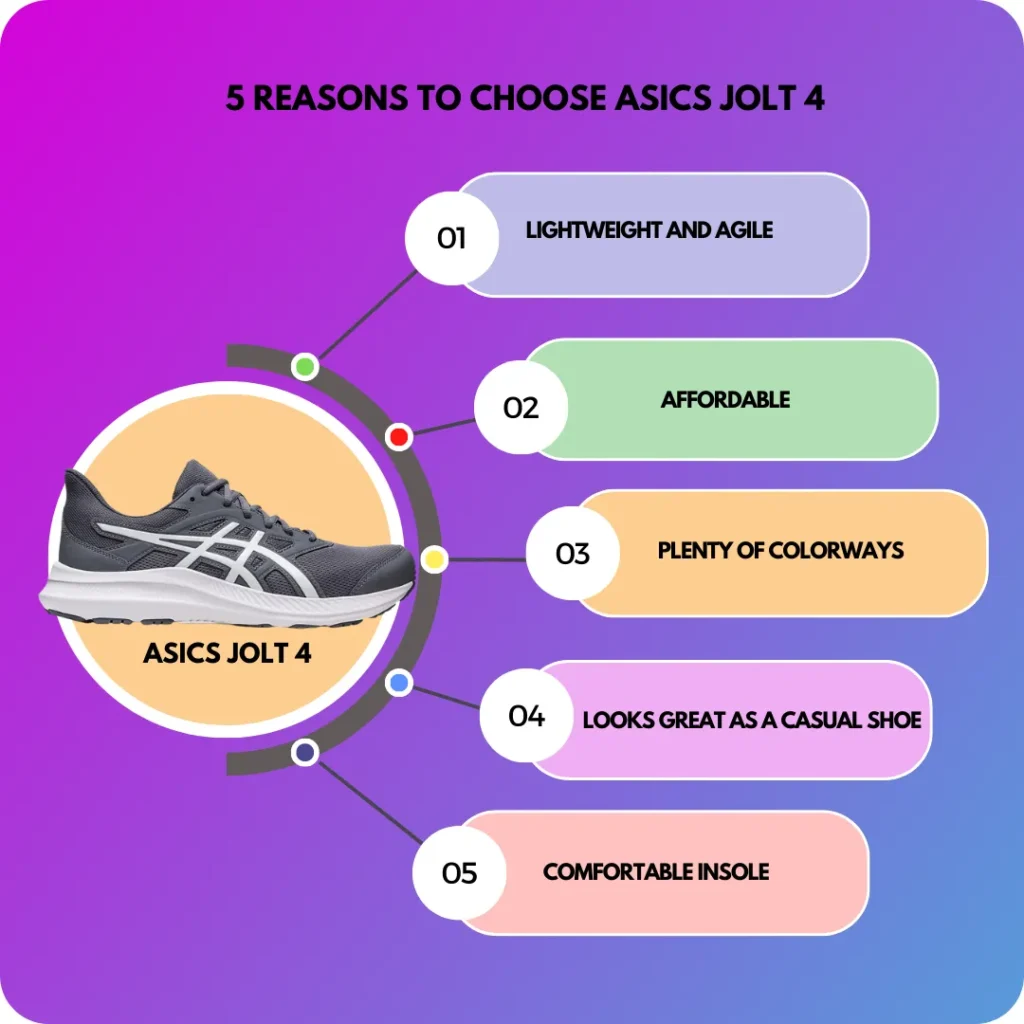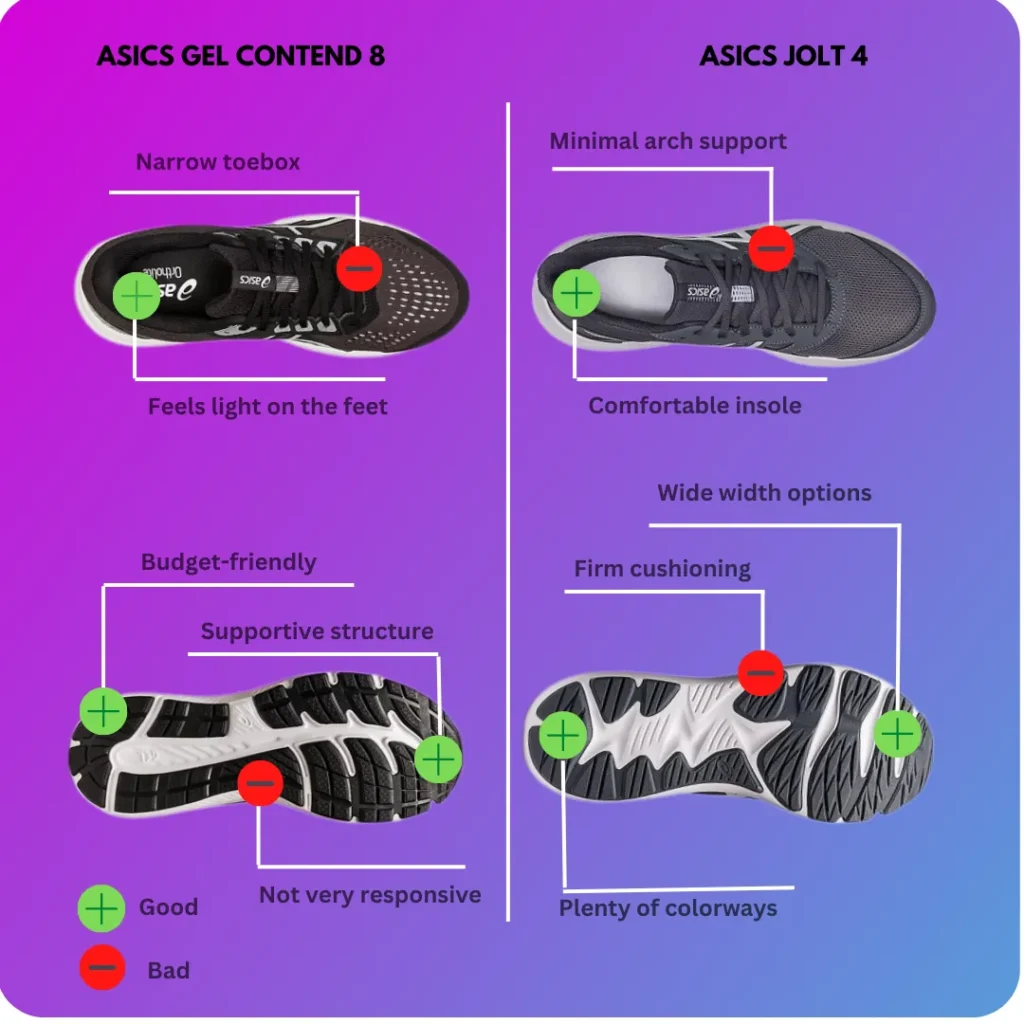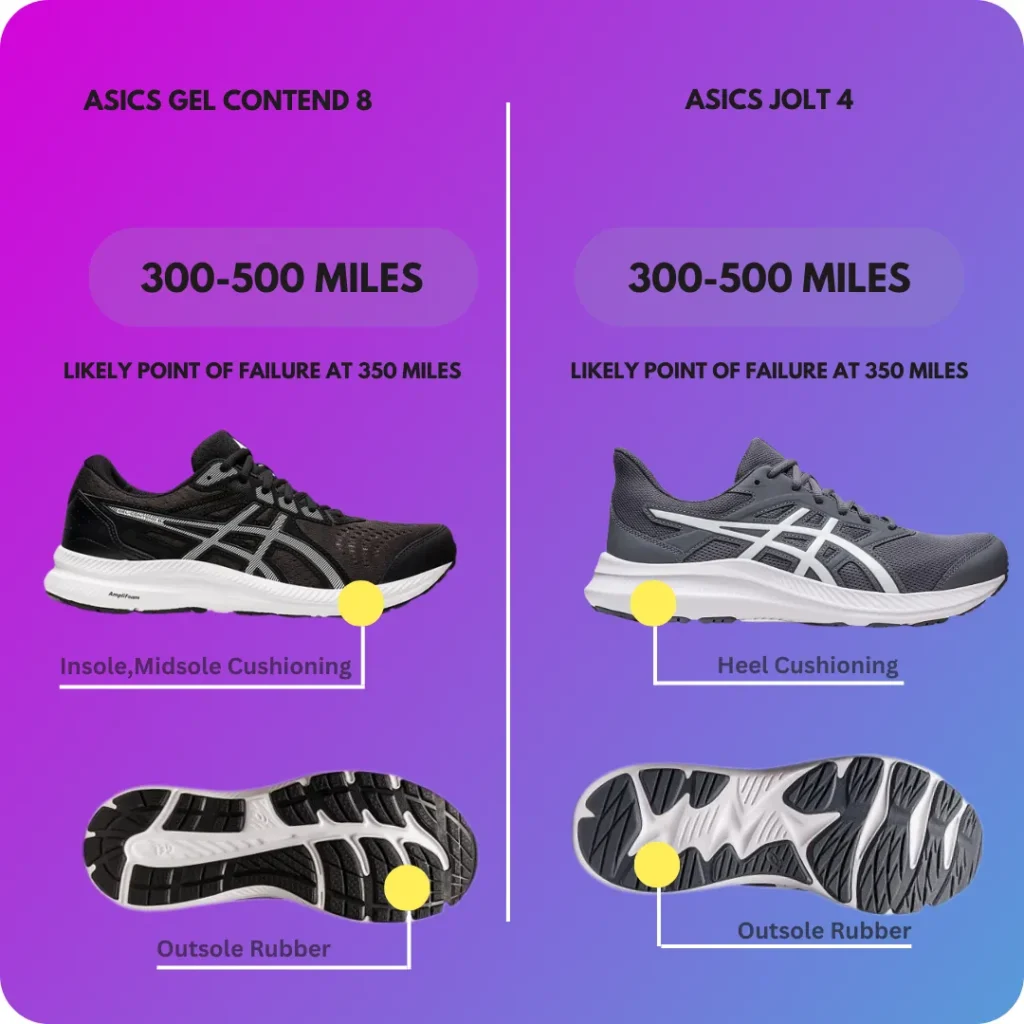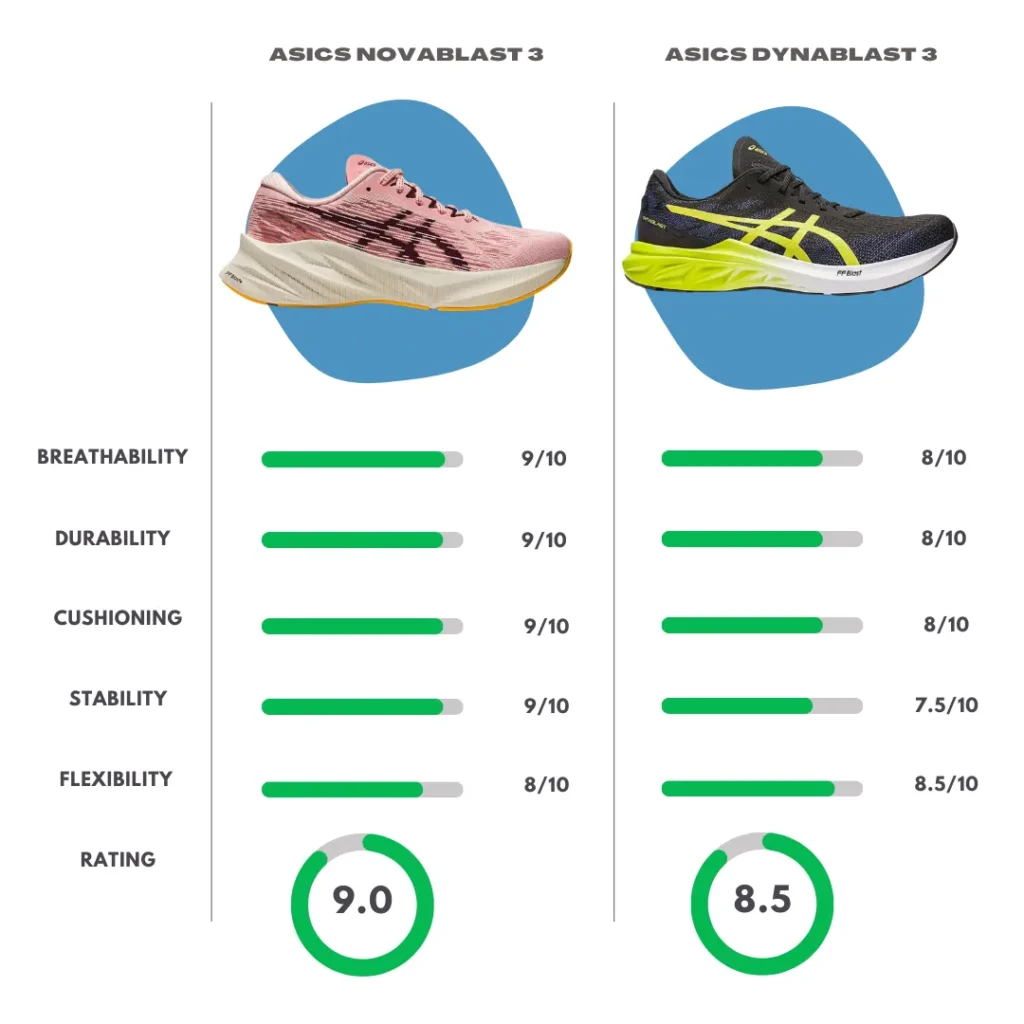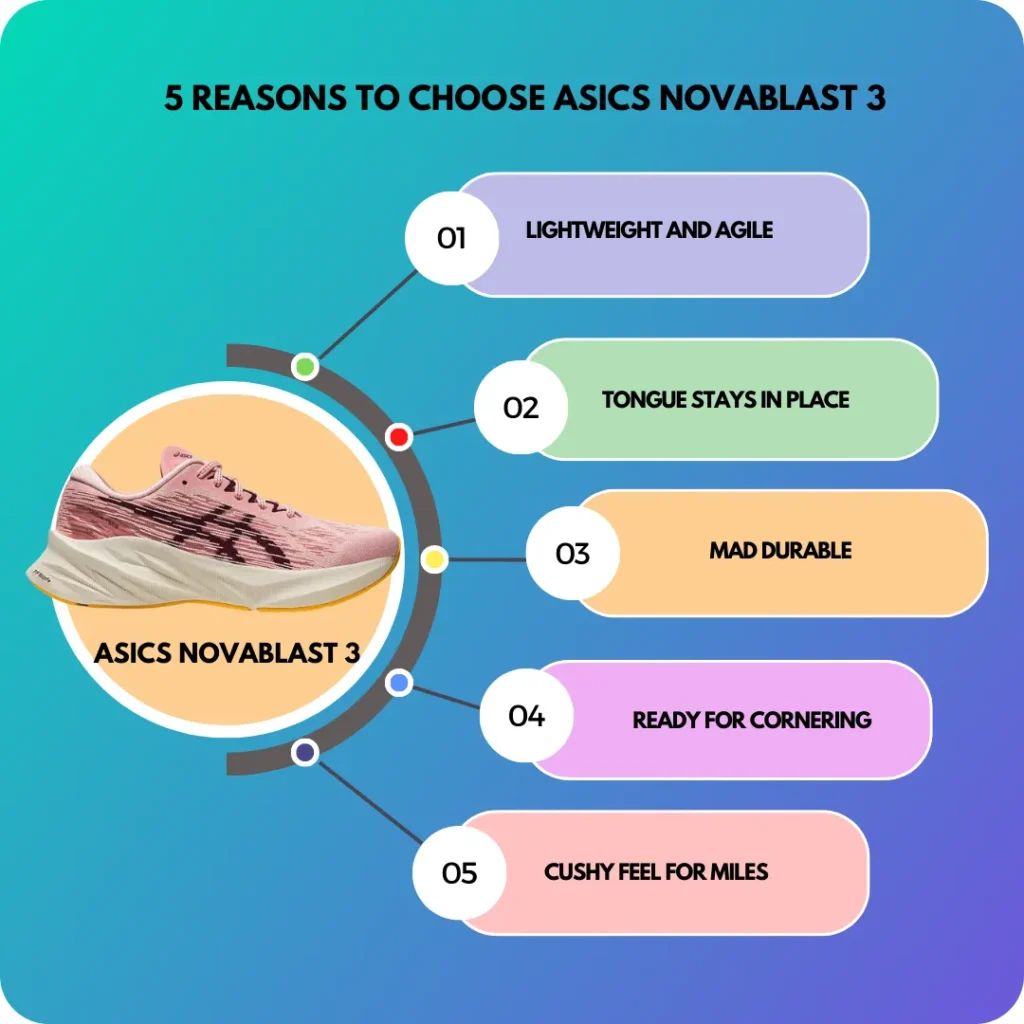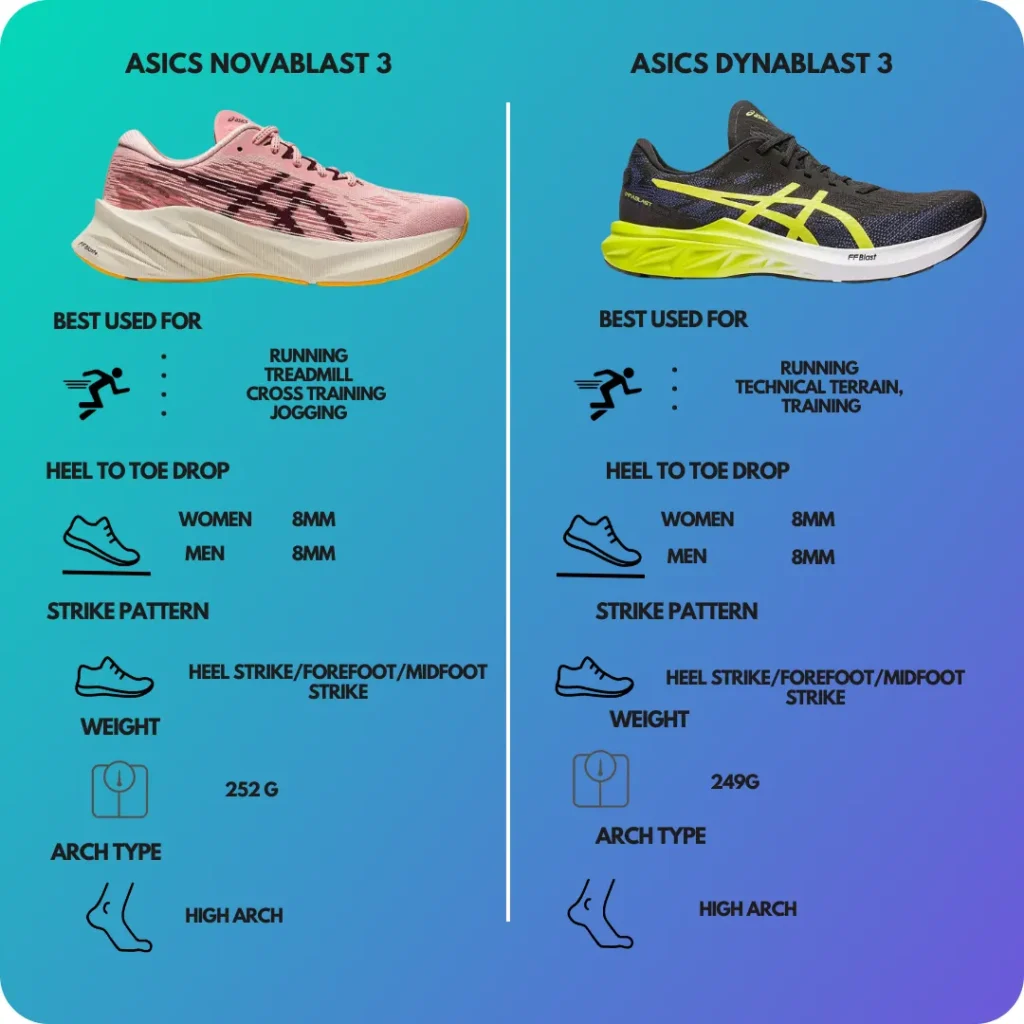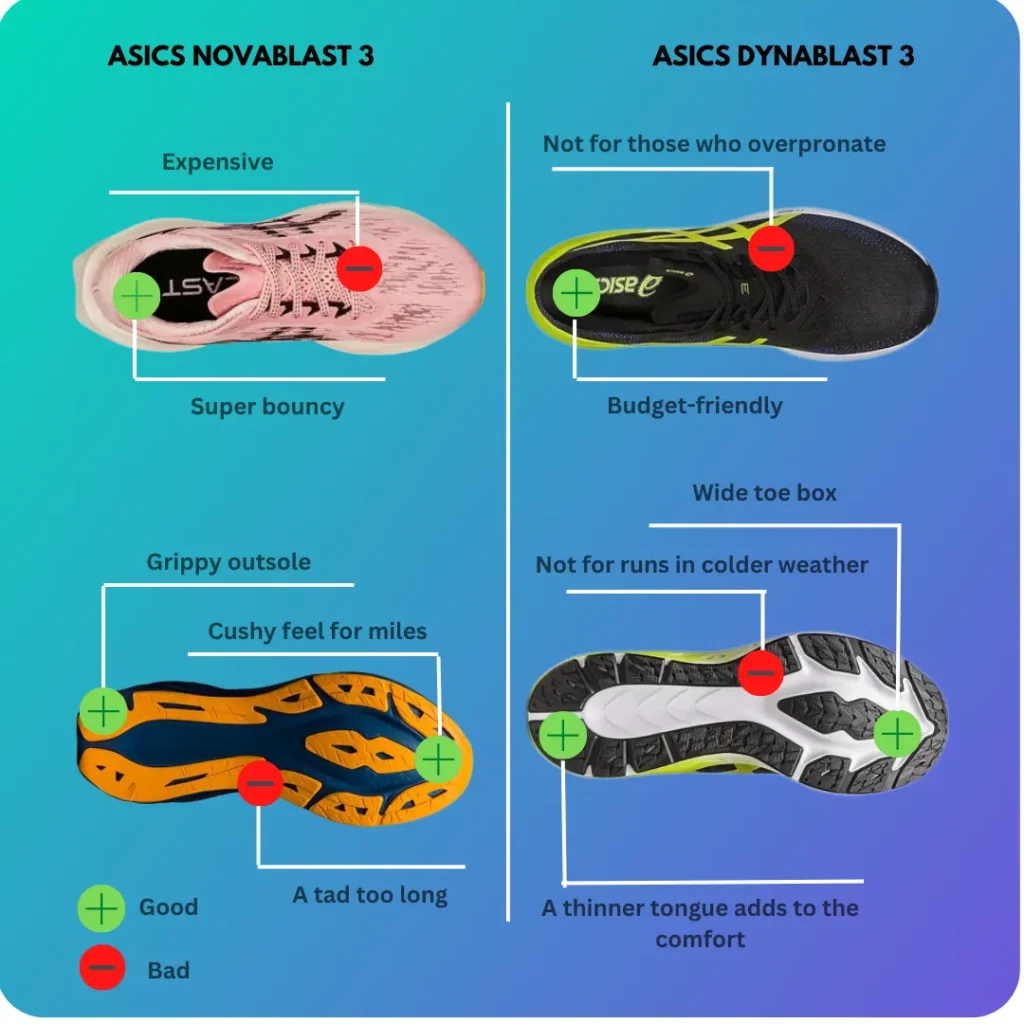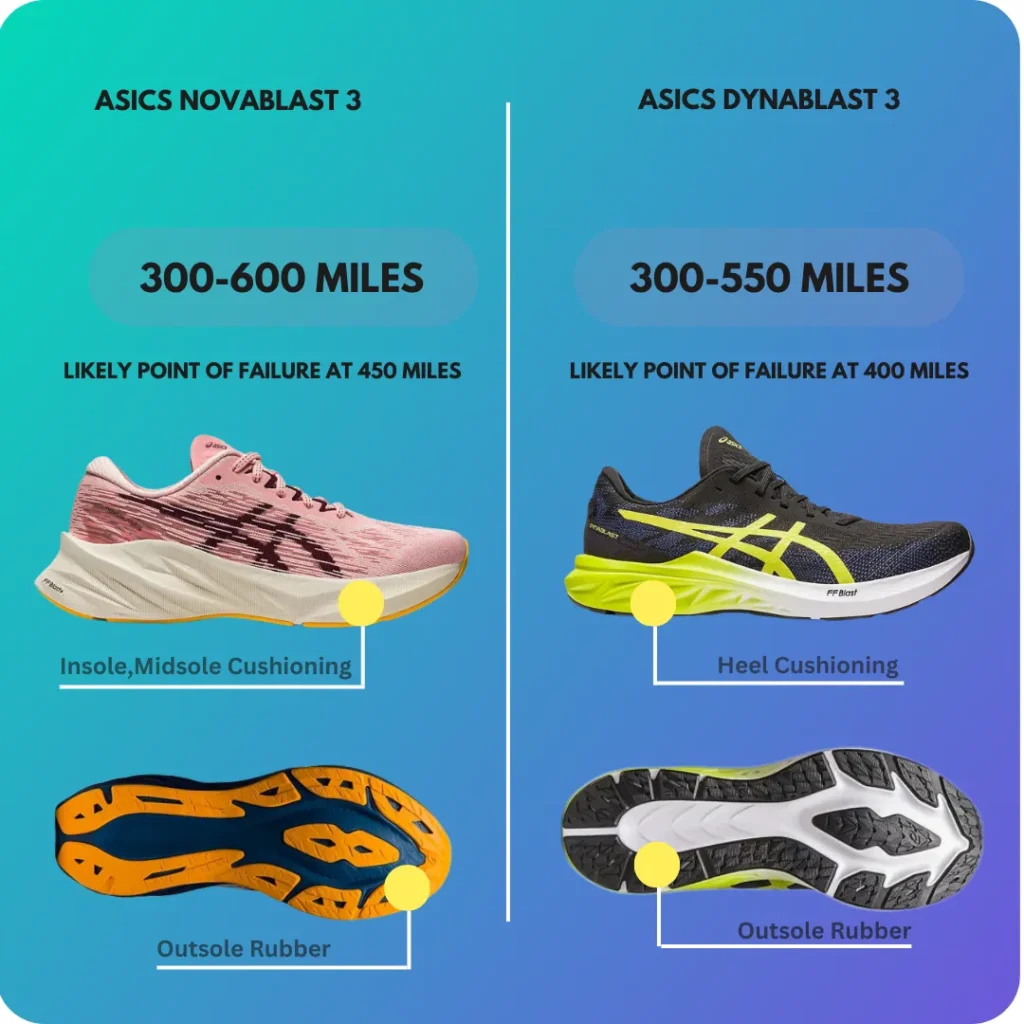Hoka Clifton 9 vs Arahi 6: Unveiling the Ultimate Running Shoe Showdown
In the dynamic world of running shoes, two titans have emerged, captivating the hearts and soles of runners worldwide: the Hoka Clifton 9 and the Arahi 6.
As avid runners lace up their shoes and hit the pavement, the question looms large – which of these Hoka One One marvels is the true champion of the track?
Strap in, as we delve into an in-depth analysis of these two running powerhouses, exploring their features, technologies, and performance, to guide you in making an informed and inspired choice for your next running companion.
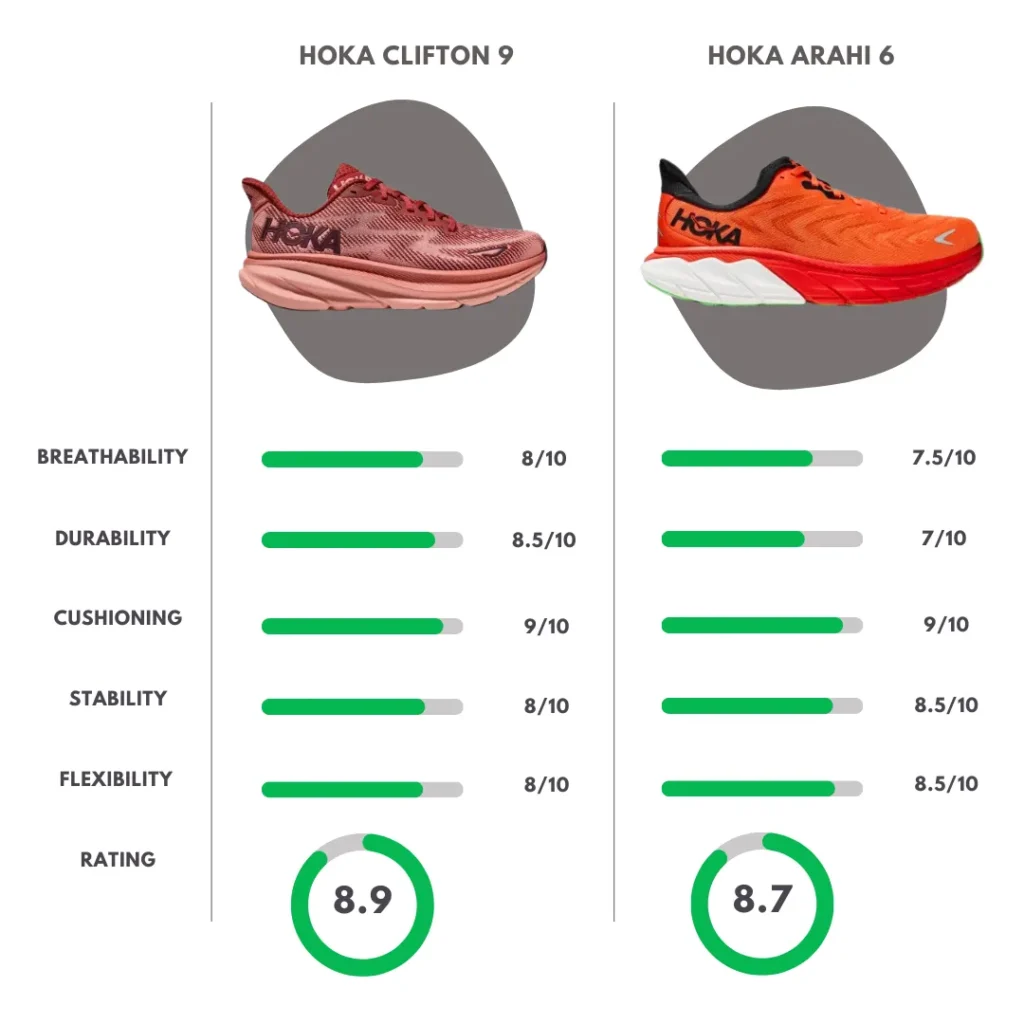
Technical Comparison Table – Hoka Clifton vs Arahi
| Category | Hoka Clifton 9 | Hoka Arahi 6 |
| Cushioning Technology | EVA Midsole | EVA Midsole with J-Frame |
| Heel Drop | 5mm | 5mm |
| Weight | Lightweight – Approx. 8.7 oz | Moderate – Approx. 9.3 oz |
| Upper Material | Engineered Mesh and Overlays | Engineered Mesh and Thin Overlays |
| Breathability | Good | Good |
| Fit | Comfortable and Supportive | Snug and Secure |
| Arch Support | Neutral | Stability and Supportive |
| Outsole Material | Rubberized Foam | Rubberized Foam |
| Traction | Reliable Grip | Reliable Grip |
| Flexibility | Standard Flexibility | Standard Flexibility |
| Pronation Control | None | Overpronation Support |
| Stability | Neutral | Stability Control |
| Durability | Durable | Durable |
| Best Use | Everyday Running | Stability and Support |
| Recommended Distance | Short to Medium Distances | Short to Medium Distances |
| Heel Counter | External Heel Counter | External Heel Counter |
You May Also Like – Hoka Clifton 9 vs Bondi 8: Decoding the Ultimate Running Shoe Showdown
Unraveling the Design
When it comes to design, both the Clifton 9 and the Arahi 6 showcase Hoka’s commitment to innovation and comfort.
The Clifton 9 boasts a neutral stance, making it a versatile choice for runners seeking an equilibrium between cushioning and responsiveness.
Its intricate blend of cushioning materials creates a sensation of running on clouds, ideal for long-distance runners and daily trainers.
On the other side of the spectrum, the Arahi 6 stands proud as a stability-focused marvel.
Engineered for overpronators, this shoe features Hoka’s proprietary J-Frame technology, acting as a gentle guiding hand to prevent unwanted foot rolling.
The Arahi 6’s stiffer foam and structured design provide the support needed to conquer those miles with confidence.
Related Post – Hoka Speedgoat 5 vs Mafate Speed 4: A Comprehensive Comparison

Related Comparison – Hoka One One Arahi 6 vs Bondi 8: Which is Best For You?
Cushioning Comfort vs Stabilizing Support
At the heart of this clash of titans lies the fundamental difference between cushioning and support.
The Clifton 9 indulges your feet in a symphony of plush cushioning, cocooning them in a world of comfort.
Its elevated stack height and strategically placed padding offer a pillowy ride, reducing impact and fatigue over extended runs.
In contrast, the Arahi 6 steps up with its stability-centric approach.
Runners grappling with overpronation will find solace in the J-Frame technology, a guardian angel that keeps the foot aligned and stable.
The Arahi 6’s blend of cushioning and support ensures a harmonious balance, providing both a responsive ride and the reassurance of controlled motion.
Also Read – Hoka Clifton 9 vs Rincon 3: Unraveling the Ultimate Running Shoe Showdown
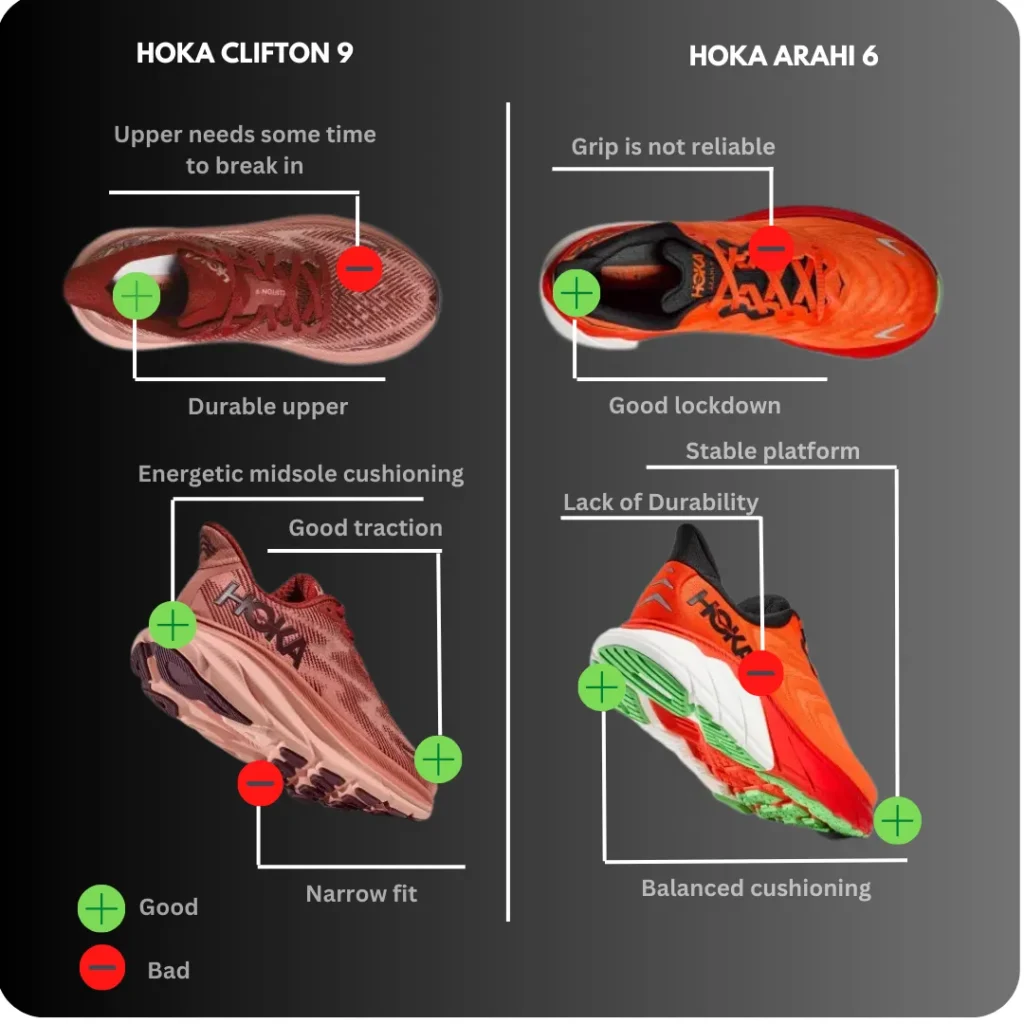
Related Comparison – Hoka Arahi 6 vs Hoka Gaviota 5: Which is Best for You?
Performance: On the Road and Beyond
When the rubber meets the road, the Clifton 9 shines as a versatile all-rounder.
Its lightweight design, combined with generous cushioning, empowers runners to tackle diverse terrains and distances.
Whether it’s a leisurely jog or an intense tempo run, the Clifton 9 rises to the occasion, delivering a consistently satisfying experience.
Meanwhile, the Arahi 6 steps up to the plate for runners seeking a touch of guidance.
Its stability-enhancing features are a boon for those aiming to conquer personal bests without compromising form.
From sprints to marathons, the Arahi 6 provides the structure needed for confident strides and optimal efficiency.
Also Read – Hoka Arahi 6 vs Hoka Mach 5: A Detailed Comparison
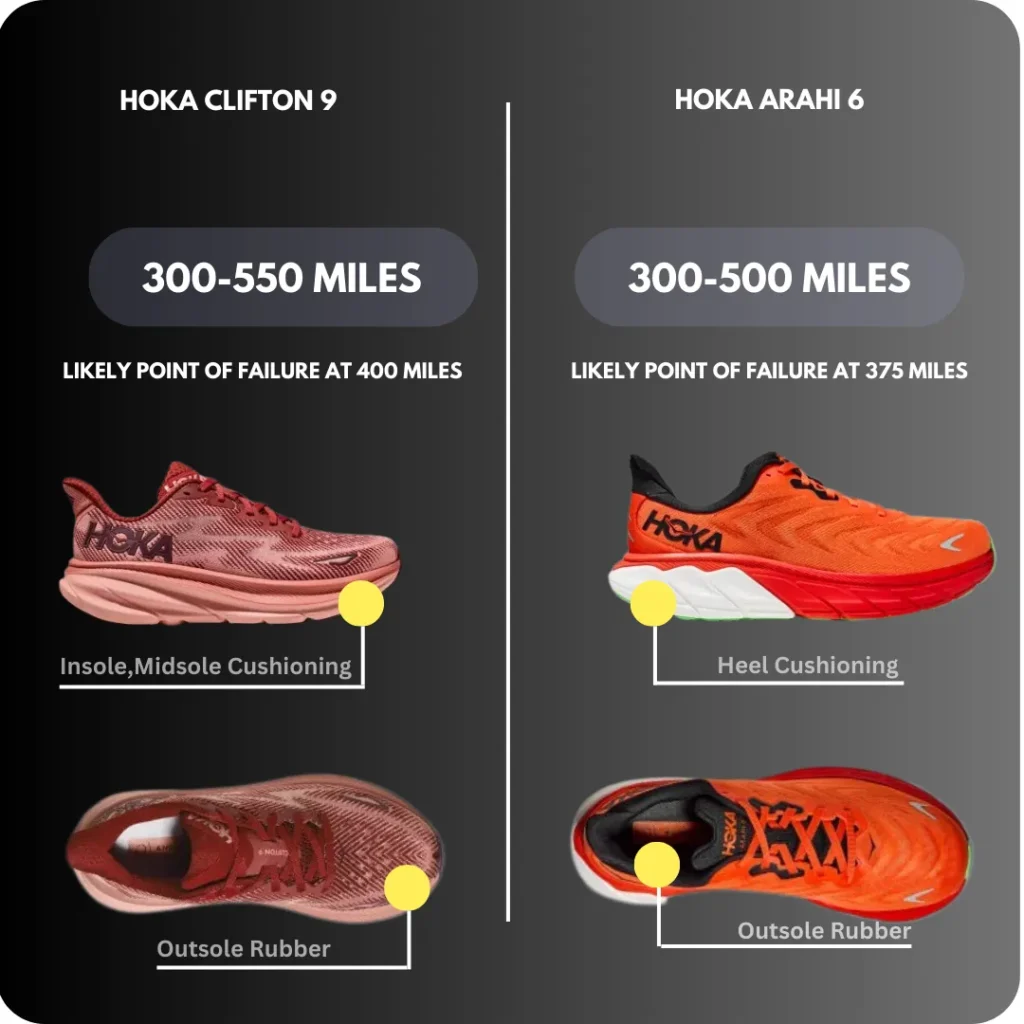
Also Read – Hoka Clifton 9 vs Hoka Mach 5: The Ultimate Running Experience
My Personal Journey with using the Hoka Clifton 9 and the Arahi 6
I take you through my experiences and help you find your perfect fit.
Let’s kick things off with the Hoka Clifton 9.
Ah, what a gem!
From the moment I slipped my feet into these cloud-like wonders, I knew I was in for something special.
The Clifton 9’s cushioning game is next level – it’s like running on a fluffy marshmallow, no kidding!
Those long-distance runs suddenly felt a lot more forgiving on my joints, and the lightweight design was a cherry on top.
I could clock in the miles without feeling like I was lugging around a ton of bricks.
The versatility of the Clifton 9 is worth a mention too – it’s as comfortable on the track as it is on those winding trails.
Now, don’t get me wrong, I do have a soft spot for speed, and the Clifton 9’s responsiveness didn’t disappoint either.
All in all, it’s like a cozy hug for my feet every time I lace ’em up.
And then we have the Arahi 6 – the stability maestro.
Now, I’ll admit, I was a bit skeptical at first. Stability shoes and I had a complicated history.
But the Arahi 6 changed the game for me.
The moment of truth came when I felt that J-Frame technology kick in.
It was like having a running buddy who gently guided my feet, especially when fatigue kicked in.
Overpronation?
Say no more, the Arahi 6 had my back – or rather, my feet.
The stiffer foam and structured design gave me the confidence to push my limits without fearing the dreaded foot roll.
Plus, it didn’t hurt that they looked sleek and stylish – a bonus when you’re pounding the pavement.
So, to answer your question about my favorite, it’s a close call, but if I had to choose, I’d say the Clifton 9 wins by a photo finish.
Its all-around performance and plush comfort just speak my running language.
But hey, both these shoes have earned their spots in my heart, and whichever one you pick, trust me, your runs are about to get a major upgrade!
Read Also – Hoka Bondi 8 vs Gaviota 5: Which is best for You?
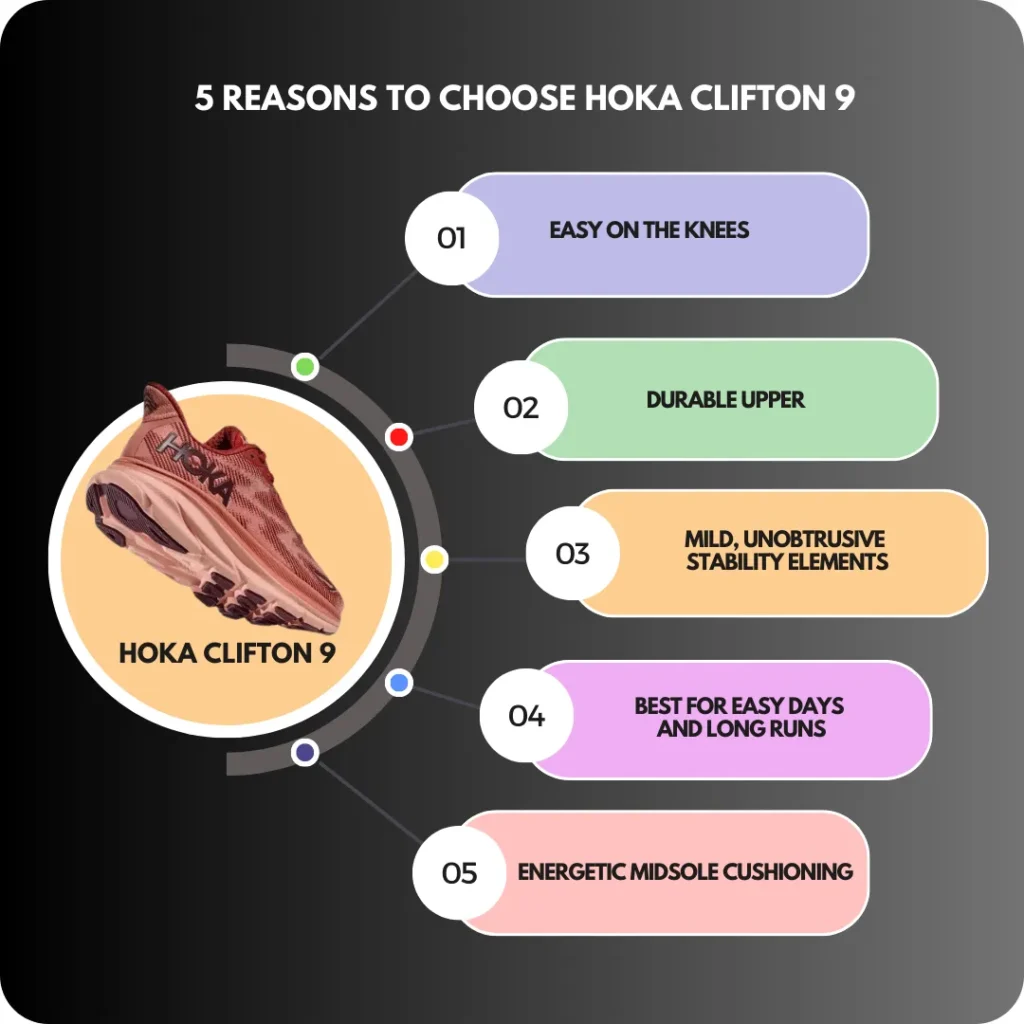
You May Also Like – Do Hokas Run Big or Small? Let Me Share My Personal Experience!
The Verdict: Choosing Your Champion
In the timeless battle of Hoka Clifton 9 vs Arahi 6, there is no clear victor – only the realization that these shoes cater to distinct preferences and running styles.
The Clifton 9 envelops you in a cocoon of cushioned delight, a true companion for those who value comfort and versatility.
On the other hand, the Arahi 6 stands as a stalwart guardian, providing stability and support for overpronators seeking a harmonious stride.
As you lace up for your next adventure, consider your unique running goals and biomechanics.
Are you a seeker of cushioned dreams or a disciple of structured steps?
Whichever path you choose, rest assured that Hoka’s commitment to innovation and quality will accompany you every step of the way.
Related Comparison – Hoka Arahi 6 vs Rincon 3: Unraveling the Best Choice for Your Run
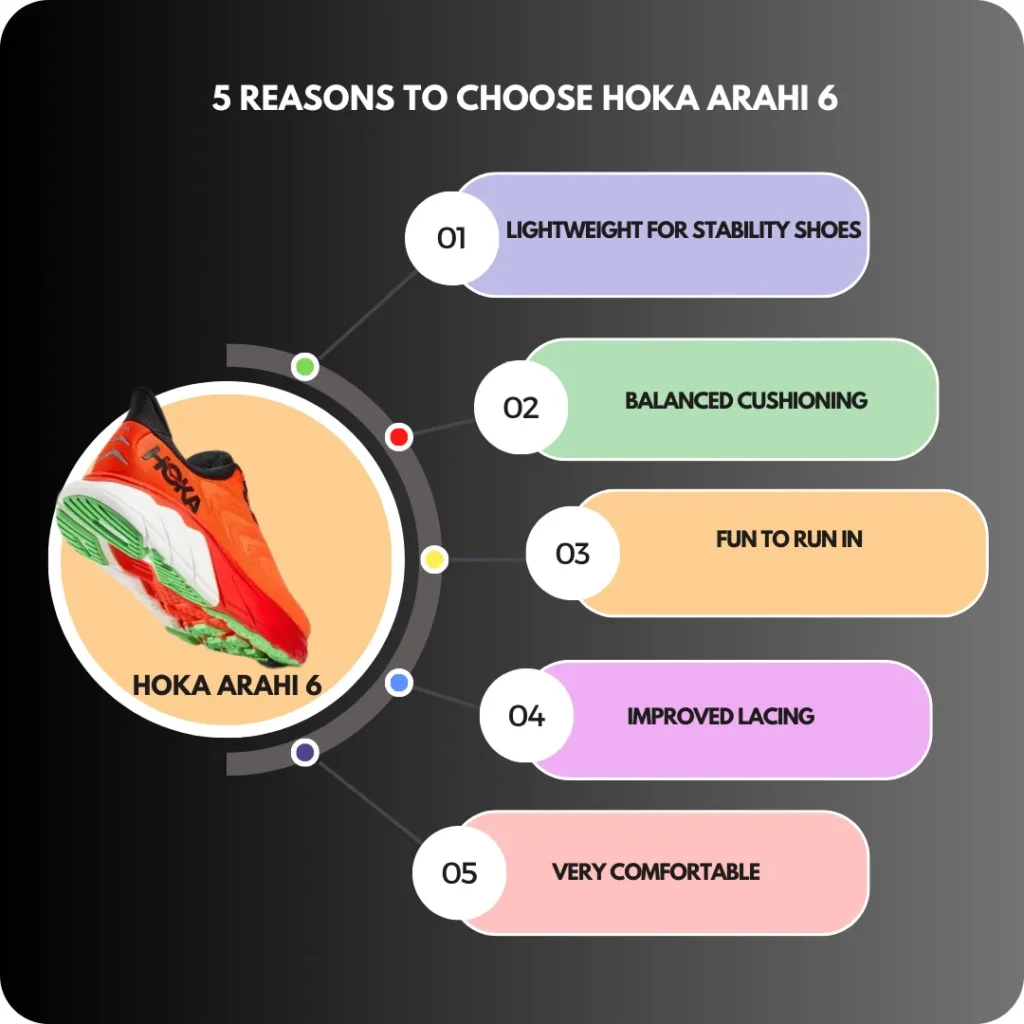
Related Comparison – Hoka Speedgoat 5 vs Challenger 7: Unveiling the Ultimate Trail Running Showdown
FAQs
What are the main differences between the Hoka Clifton 9 and Arahi 6?
- The Hoka Clifton 9 is designed as a neutral running shoe, focusing on cushioning and versatility for a comfortable ride.
- The Arahi 6, on the other hand, is categorized as a stability shoe, equipped with Hoka’s J-Frame technology to provide support and combat overpronation.
How does the cushioning compare between Clifton 9 and Arahi 6?
- The Clifton 9 offers a plush and cushioned experience, making it an ideal choice for runners seeking a soft landing and reduced impact during their runs.
- The Arahi 6 incorporates a balance of cushioning and stability features, ensuring a comfortable yet supportive ride for runners with overpronation tendencies.
Who would benefit most from the Hoka Clifton 9?
The Hoka Clifton 9 is well-suited for neutral runners or those who prefer a cushioned and comfortable ride for various distances, including daily training and long runs.
Is the Arahi 6 suitable for runners with overpronation?
Yes, the Arahi 6 is specifically designed for runners who overpronate. Its J-Frame technology provides medial support to prevent excessive inward rolling of the foot, promoting a more balanced and efficient stride.
How do the design and aesthetics of these shoes differ?
- The Clifton 9 features a neutral design with a focus on comfort and cushioning, making it a versatile choice for various running styles and outfits.
- The Arahi 6 incorporates stability elements into its design, with a slightly more structured appearance to reflect its support-focused features.
Can I use the Clifton 9 or Arahi 6 for different types of running surfaces?
Yes, both the Clifton 9 and Arahi 6 are versatile enough to be used on a variety of running surfaces, including roads, tracks, and well-groomed trails.
Which shoe is better for long-distance running?
The Clifton 9’s plush cushioning makes it a popular choice for long-distance running, providing a comfortable and supportive experience for extended periods.
Does the Arahi 6 sacrifice comfort for stability?
No, the Arahi 6 strikes a balance between comfort and stability, making it a reliable choice for runners who seek both support and cushioning in their shoes.
Are there any differences in the fit of the Clifton 9 and Arahi 6?
While fit can be subjective, both models generally offer a comfortable and accommodating fit. It’s recommended to try them on and determine which feels better for your foot shape.
Can the Clifton 9 or Arahi 6 help improve my running performance?
Both models are designed to enhance the overall running experience. The Clifton 9’s cushioning can reduce impact and fatigue, while the Arahi 6’s stability features can contribute to improved form and efficiency.
Hoka Clifton 9 vs Arahi 6: Unveiling the Ultimate Running Shoe Showdown Read More »
